Photo
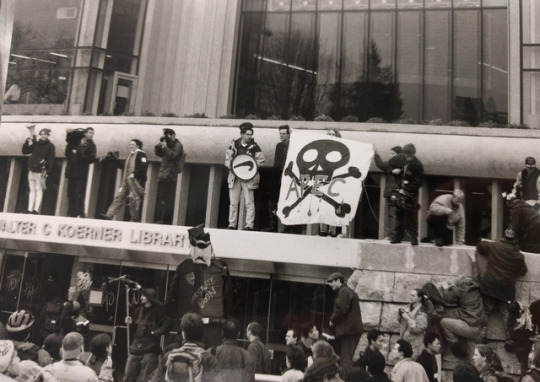
APEC Alert—an ‘Affair’ to remember
Text by Steph Glanzmann, Noni Nabors, and Marisa Pavone
Edited by Alexandra Bischoff and Anna Tidlund
In collaboration with UBC Geography Department’s Dr. Jessica Dempsey and her Fall 2017 GEOG 419 class, students were invited to submit archival based research for publication on the Both/And blog. The class thematic surrounded societal amnesia. Dempsey was interested in having students investigate major efforts for social change which had occurred in the past, the memories of which have not persisted in present social consciousness.
On November 25, 1997, anti-globalization activists at the University of British Columbia (UBC) Vancouver campus harnessed the attention of the nation during the Asia Pacific Economic Cooperation (APEC) Leaders’ Summit, in a protest that became known as the “APEC Affair”. APEC is an organization consisting of Pacific Rim countries seeking to promote free trade, economic cooperation, economic growth and prosperity among member states [1]. The APEC Affair garnered nation-wide media attention after local RCMP used pepper spray against nonviolent student protesters [2][3][4]. Unfortunately, the events that unfolded on November 25 (and the sequential court cases [5]) largely overshadowed the purpose of the anti-APEC campaign. This report intends to show how student organizers in opposition to APEC were able to engage and mobilize students on the UBC campus. With many of the organizers’ records and external communications accessible [6][7], we are able to analyze the principles, strategies and tactics used to mobilize the student body at UBC.
The APEC Affair occurred during a time of broader anti-globalization movements, which arose as a form of resistance to the widespread neoliberal policies being implemented around the globe [8]. The structural adjustments that came with globalization policies disproportionality impacted economies of Africa, Asia and Latin America and benefited those of the Global North [9], while simultaneously diluting democracy across borders and eroding workers rights around the world [10]. Other international bodies with similar neoliberal motivations include the International Monetary Fund and the World Trade Organization, which both promote trade liberalization internationally [11].
In January 1997, outgoing UBC President Dr. David Strangway announced that the UBC Vancouver campus, including the Museum of Anthropology, would be the venue for the sixth annual APEC Leaders’ Summit. This would come to be the biggest and most expensive private meeting in Canada [12], with the intent of fostering economic partnerships between member states [13]. The decision was widely criticized for being outside Strangway’s scope of decision-making power, sparking anger among students who were not consulted about the decision [14][15]. Further to this, anti-APEC students and community members fundamentally opposed the meeting on the grounds that it was to be a meeting place to implement corporate globalization agendas [16]. The fall after the summit announcement, several students began organizing efforts against the APEC Leaders’ Summit and referred to themselves as “APEC Alert” [17].
APEC Alert “considered APEC to be undemocratic, complicit in the erosion of human rights . . . fostering a society of consumption, and promoters of environmental destruction” [18]. In resistance, APEC Alert created a powerful campaign that included diverse tactics and messaging, which resonated with a large student base. Approximately 1,500 individuals protested in opposition to the APEC summit [19][20]. Protesters were concerned that the APEC summit would be focused on trade agreements without considering the human rights abuses of Indonesia President Suharto and Chinese General Secretary Zemin, as well as the environmental and social ills of the trade deals [21][22]. Although the protest itself was peaceful, 48 students were detained and multiple individuals were pepper sprayed by police [23][24].
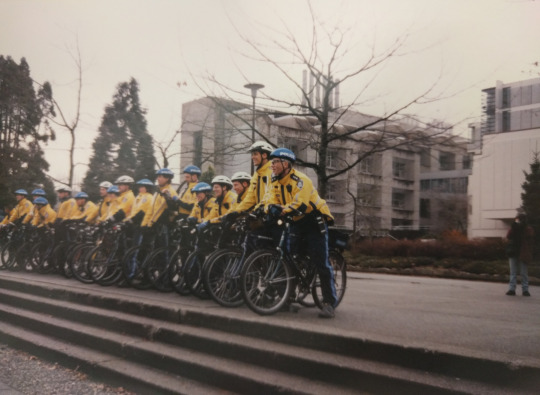
Organizing materials and threads of communication used to mobilize UBC campus have been preserved through email lists, news articles, and local archives, but there has been little work to re-centre this story of student resistance to the conscious of the UBC community. By threading together primary sources, first-hand accounts and anti-APEC material, we seek to create a roadmap for future student organizers and to distribute the story of a meaningful student-led movement on UBC campus. By framing the voices of APEC-Alert organizers and protestors, our work serves to counterbalance the largely institutional and legalist research already done on the APEC Affair.
We visited the UBC Alma Mater Society (AMS), Museum of Anthropology (MOA) and Morris and Helen Belkin Art Gallery archives, looking at collections both online and in-person. When visiting the AMS and MOA archives, we focused on student-generated content such as leaflets, posters, event itineraries and email communications. Archival sources included a Vancouver-wide anarchist email list used to coordinate events and as well as circulate alternative media. This list, which included over 24 threads containing the term “APEC” in their titles, acts as the backbone of our research as we used it to piece together the larger organizing process and identify key members of APEC Alert [25].
We compiled a list of potential interviewees and, ultimately, interviewed four individuals: Garth Mullins, a writer based in East Vancouver; Jonathan Oppenheim, a former UBC student and APEC Alert organizer; Katja-Anton Cronauer, also a former UBC student and APEC Alert organizer; and Jamie Doucette, a former UBC student and activist taken into custody during the APEC Affair.
These interviews revealed many aspects of the APEC Affair and the campus culture of 1997. For one, the success of the APEC Affair is largely credited to the diverse tactics used by organizers in mobilizing 1,500 protesters. Organizers were able to foster a successful movement on campus because of the diverse tactics they used to activate the student body. APEC Alert split their campaign into three sections: “Refuse APEC,” “Summit Under Siege,” and “Crash The Summit” [26].
Refuse APEC spanned from the beginning of September to November 17, 1997 [27]. This period involved a series of acts of civil disobedience that engaged students as well as created situations which forced UBC administration to act. When asked about the strengths of APEC Alert’s campaign, past member Jonathan Oppenheim said, “[protesters were] effective at creating situations where we put both the university and the state . . . at a loss of what to do. We were quite good at creating situations where they were kind of forced to choose. [We pushed] them in situations they were uncomfortable with” [28]. Examples of these situations include camping at the Museum of Anthropology and the AMS Student Union Building, tabling motions for both the AMS and the UBC Board of Governors to overturn the decision to host the Summit [29], a series of road hockey games on the driveway of the Norman Mackenzie house [30] and a Halloween campus march that ended with two student being detained for writing “BOO APEC” on a newly renovated building [31]. The Refuse APEC period was also used to educate the student body through both informational and provocative posters, debates on campus, classroom announcements, film screenings and talks.
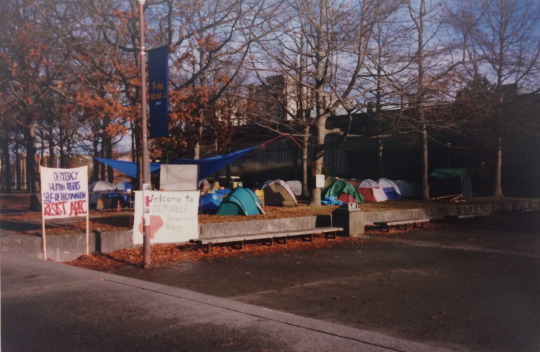
The next phase, Summit Under Siege, was a transition point in the campaign where organizers ramped up the intensity and size of anti-APEC demonstrations in preparation for the beginning of summit proceedings on November 19. Summit Under Siege began on November 17 with a tent city outside of the AMS Student Union Building (SUB) called Democracy Village, or DemoVille for short, which lasted until November 25 [32]. Other UBC student groups were encouraged to show their support by setting up a tent in DemoVille and to participate in the ongoing civil disobedience trainings, cook-outs and workshops. On November 21, APEC Alert held a concert next to the restricted area of the Museum of Anthropology called “Rock Against APEC” [33]. On November 24—the day before the Leaders’ Summit—APEC Alert organized a campus wide walk-out, directing students, faculty and Vancouver supporters to a day-long teach-in called “Free University” in the SUB.
Summit Under Siege culminated with the final phase of the campaign: Crash The Summit. On the morning of November 25, 1997, protesters were invited to gather at the Goddess of Democracy statue for a “Refuse APEC Festival”, which included street theatre, music, speeches and civil disobedience preparation [34]. Over 1,500 protesters marched throughout campus in opposition to the Leaders Summit, eventually clashing with police, finding themselves on the receiving end of pepper spray and excessive force [35][36].
Our interviewees spoke of the necessity of mixed-methods organizing, emphasizing that any movement will not succeed without them. Katja-Anton Cronauer recalled [37]:
What I liked was that it was very varied—our strategies. We employed our educations, had workshops, showed films, invited presenters for talks, plastered the campus with posters, did civil disobedience actions, beautified the campus—as we called it—with chalk and paint and posters. So I liked that because it drew a lot of different people in.
During the APEC Affair there were events tailored for those with deep, academic knowledge of power systems and international affairs, as well as events for those less familiar. Garth Mullins remembers thinking, “this is great, are you kidding me? We’ve like broken through to the Zeitgeist or whatever, because the truth is [UBC] . . . was not a hotbed of radicalism” [38].
People were made to feel welcome through these tactics regardless of how much they knew when they arrived at an event. In this way a welcoming atmosphere was created, and increased awareness about APEC attracted more individuals to the events who were curious. The multitude of events leading up to the summit generated momentum for the main protest, Crash The Summit.
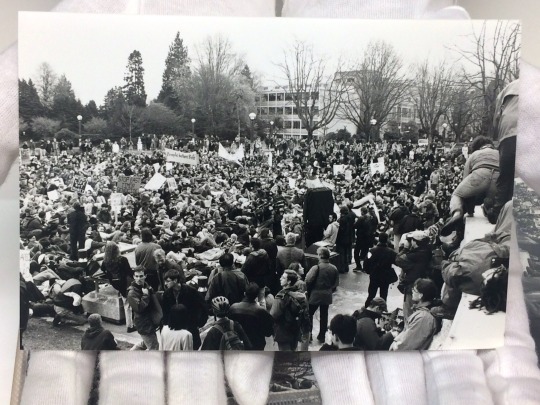
The gender dynamics in APEC Alert are also worth considering. While APEC Alert centered anti-oppression and consensus as guiding principles in their organizing, in our research it was clear that certain identities and voices were missing from conversations while others dominated. Cronauer’s thesis, for example, suggests that women and non-binary individuals were underrepresented in APEC Alert email exchanges [39]. Furthermore in our interview, Cronauer spoke of a “boy’s club” within APEC Alert that implicitly excluded women and non-binary members. According to Cronauer, there “was difference among groups. There was a boys club, [ . . . and] there was a core group which I was a part of, which was the next inner group” [40].
Cronauer later went on to say that following the Summit, a group of female organizers created a women’s only group to discuss the sexism they faced both from police and from within APEC Alert [41]. Seven out of eight persons we contacted for interviews identify as cis-male. It is not immediately clear whether this is because the archive selectively overrepresents male voices and/or whether women and non-binary individuals were excluded from organizing.
In addition to the gender power dynamics, Cronauer recounted how APEC Alert was predominately white, a fact she believes influenced their activities. Cronauer recalls that “using [tactics] like ‘Hockey Against APEC’ —which as I know is a very white Canadian game,” could have been a subtle form of exclusion [42]. In fact all our interviewees are white, something we realized only at the conclusion of our interviews.
It is impossible to say what the specific impacts of a predominately white and male organizing leadership are, especially within the scope of this report. Regardless, it calls to attention critical questions of power structures within justice-oriented organizing groups. Who has the ability to be speak, and to be heard, as well as whose voice is represented in archival histories are crucial and power-laden questions.

Our interviewees stressed that, up until the day of the summit, they could not have predicted whether Crash The Summit would be “successful” or not. There is no benchmark for “success” in such movements, so describing it as such is fickle. They emphasized that, rather than focusing on the “success” of events, aspiring organizers must keep an eye on their long-term goals. As Katja-Anton Cronauer said, “I think one important thing is: keep going” [43].
The APEC Affair occurred 20 years ago and yet we suspect the majority of students on UBC campus are unaware of it. We believe there is still a need for student movements today, including the movement to divest UBC from fossil fuels, which stem from the same neoliberal forces the anti-APEC movement rallied against. It is ironic that 20 years ago UBC students protested against the widespread implementation of neoliberal policies, while students today are affected by the consequences of those policies—yet are unaware of the efforts of the students before them. We encourage future research into the connection between this lack of memory, and the student body’s perceptions of social action on campus today.
Notes
[1] Asia-Pacific Economic Cooperation. "Mission Statement." Asia-Pacific Economic Cooperation. Accessed April 12, 2017. http://www.apec.org/About-Us/About-APEC/Mission-Statement.
[2] Winter, James. "Canadian PM in hot water over APEC '97." Green Left Weekly. September 5, 2016. Accessed June 21, 2017. https://www.greenleft.org.au/content/canadian-pm-hot-water-over-apec-97.
[3] Pue, W. Wesley. Pepper in our eyes: the APEC affair. Vancouver: UBC Press, 2000.
[4] Abbate, Gay. "Mounties assailed for APEC bungling." The Globe and Mail. March 21, 2009. Web. Accessed June 21, 2017. http://www.theglobeandmail.com/news/national/mounties-assailed-for-apec-bungling/article1032642/.
[5] Ibid.
[6] Cronauer, Katja-Anton. "Activism and the Internet: a socio-political analysis of how the use of electronic mailing lists affects mobilization in social movement organizations." PhD diss., University of British Columbia, April 2004.
[7] A-Infos News Services: News about and of interest to anarchists. Accessed April 12, 2017. http://www.ainfos.ca/A-Infos97/4/index.html#545.
[8] Ericson, Richard and Aaron Doyle. "Globalization and the policing of protest: the case of APEC 1997." British Journal of Sociology 50, no. 4 (1999): 589-608. Accessed June 21, 2017. doi:10.1080/000713199358554.
[9] Redclift, Michael and Colin Sage. "Global Environmental Change and Global Inequality." International Sociology 13, No. 4 (1998): 499-516. Accessed June 21, 2017. doi:10.1177/026858098013004005.
[10] Biebricher, Thomas. "Neoliberalism and Democracy," Constellations 22, No. 2 (2015): 255-266. Accessed April 12, 2017, doi:10.1111/1467-8675.12157.
[11] Chorev, Nitsan and Sarah Babb. "The crisis of neoliberalism and the future of international institutions: A comparison of the IMF and the WTO." Theory and Society 38, No. 5 (2009): 459-84. doi:10.1007/s11186-009-9093-5.
[12] Mackin, Bob and Geoff Dembicki. "Mercer Blasted APEC Protesters with Pepper Spray." The Tyee. Web. October 22, 2009. Accessed April 12, 2017. https://thetyee.ca/News/2009/10/22/MercerPepperSpray/.
[13] Asia-Pacific Economic Cooperation. "Mission Statement." Asia-Pacific Economic Cooperation. Accessed April 12, 2017. http://www.apec.org/About-Us/About-APEC/Mission-Statement.
[14] Clark, J. "APEC Economic Summit." The Ubyssey (Vancouver): 3. January 10, 1997. Vol 78 Iss 24. Web. Accessed April 12, 2017. https://open.library.ubc.ca/collections/ubcpublications/ubysseynews/items/1.0127434.
[15] Cronauer, Katja-Anton and Nicole Capler. "APEC-Alert voices views." UBC News: News from the University of British Columbia. July 10, 1997. Web. Accessed April 14, 2017. http://news.ubc.ca/ubcreports/1997/97sep04/97sep4let.html.
[16] Ibid.
[17] Mackin, Bob and Geoff Dembicki. "Mercer Blasted APEC Protesters with Pepper Spray." The Tyee. October 22, 2009. Web. Accessed April 12, 2017. https://thetyee.ca/News/2009/10/22/MercerPepperSpray/.
[18] Doyle, Alan. “B.C. Civil Liberties Association - APEC Inquiry fonds,” December 2002, last revised September 2010. Finding aid at the University of British Columbia Archives, Vancouver, BC. Accessed April 12, 2017. https://www.library.ubc.ca/archives/u_arch/bc_civil_liberties_association.pdf.
[19] Nuttal-Smith, Chris and Sarah Galashan. “APEC slams UBC.” The Ubyssey (Vancouver): 1. November 28, 1997. Vol 72 Iss 23. Web. Accessed June 7, 2017. https://open.library.ubc.ca/collections/ubcpublications/ubysseynews/items/1.0126666#p0z-2r0f.
[20] Doyle, Alan. “B.C. Civil Liberties Association - APEC Inquiry fonds,” December 2002, last revised September 2010. Finding aid at the University of British Columbia Archives, Vancouver, BC. Doyle, A. 2002. B.C. Civil Liberties Association - APEC Inquiry fonds. UBC Archives. Accessed April 12, 2017. https://www.library.ubc.ca/archives/u_arch/bc_civil_liberties_association.pdf.
[21] Ibid.
[22] Cronauer, Katja-Anton and Nicole Capler. "APEC-Alert voices views." UBC News: News from the University of British Columbia. July 10, 1997. Web. Accessed April 14, 2017. http://news.ubc.ca/ubcreports/1997/97sep04/97sep4let.html.
[23] Pecho, J. “APEC Inquiry Collection (various collectors),” 2008. Finding aid at the University of British Columbia Archives, Vancouver, BC. Accessed April 12, 2017. http://www.library.ubc.ca/archives/u_arch/apec_coll.pdf.
[24] Bradley, Nicholas, and Daliah Merzaban. “APEC remembered: two years later.” The Ubyssey (Vancouver): 1-2. November 23, 1999. Vol 81 Iss 20. Web. Accessed April 12, 2017. https://open.library.ubc.ca/collections/ubcpublications/ubysseynews/items/1.0128705#p0z-2r0f.
[25] A-Infos News Services: News about and of interest to anarchists. Accessed April 12, 2017. http://www.ainfos.ca/A-Infos97/4/index.html#545.
[26] Oppenheim, Jonathan. "(en) Summit Under Siege!" Forum post. A-Infos News Services: News about and of interest to anarchists. October 30, 1997. Web. Accessed April 12, 2017. www.ainfos.ca/A-Infos97/4/0320.html.
[27] Ibid.
[28] Oppenheim, Jonathan. "Questions on APEC Alert." Online interview by Steph Glanzmann. March 9, 2017.
[29] Bradley, Nicholas, and Daliah Merzaban. “APEC remembered: two years later.” The Ubyssey (Vancouver): 1-2. November 23, 1999. Vol 81 Iss 20. Web. Accessed April 12, 2017. https://open.library.ubc.ca/collections/ubcpublications/ubysseynews/items/1.0128705#p0z-2r0f.
[30] APEC Alert. "UBC PRESDIENT WANTS THE ARREST OF STUDENTS FOR PLAYING ROAD HOCKEY." [sic] British Columbia Anarchist Association. Geocities, October 29, 1997. Web. Accessed April 12, 2017. http://www.geocities.ws/CapitolHill/6322/apec.htm.
[31] The Ubyssey. "The Circus Comes to Campus." The Ubyssey (Vancouver): 10. November 4, 1997. Web. Accessed April 12, 2017. https://open.library.ubc.ca/collections/ubcpublications/ubysseynews/items/1.0127649#p8z-6r0f:halleen%20APEC.
[32] Howe, Brendan. "B.C. APEC Protest." UWO Gazette (London, ON). November 21, 1997. Vol 91 Iss 48. University of Western Ontario. Web. Accessed April 12, 2017. http://www.usc.uwo.ca/gazette/1997/November/21/News3.htm.
[33] Oppenheim, Jonathan. "(en) Summit Under Siege!" Forum post. A-Infos News Services: News about and of interest to anarchists. October 30, 1997. Web. Accessed April 12, 2017. www.ainfos.ca/A-Infos97/4/0320.html.
[34] Ibid.
[35] Douglas Quan, “Necessary force: Students accuse police of brutality”. The Ubyssey (Vancouver): 1. Vol 79 Iss 23. 28 November 1997. Web. Accessed 8 June 2017. https://open.library.ubc.ca/collections/ubcpublications/ubysseynews/items/1.0126666#p0z-5r0f:necessary%20force:%20Students%20accuse%20police%20of%20brutality
[36] Alan Doyle. “B.C. Civil Liberties Association - APEC Inquiry fonds,” December 2002, last revised September 2010. Finding aid at the University of British Columbia Archives, Vancouver, BC. Doyle, A. 2002. B.C. Civil Liberties Association - APEC Inquiry fonds. UBC Archives. Accessed April 12, 2017. https://www.library.ubc.ca/archives/u_arch/bc_civil_liberties_association.pdf.
[37] Kajta-Anton Cronauer. "Questions on APEC Alert." Online interview by Steph Glanzmann and Noni Nabors. March 23, 2017.
[38] Garth Mullins. "Questions on APEC Alert." Interview by Noni Nabors. March 15, 2017.
[39] Cronauer’s “Activism and the Internet: A socio-political analysis of how the use of mailing lists affects mobilization in social movement organizations” (2004) discovered that from the APEC-Alert email list 72 messages were sent by women, 266 were sent by men, and 17 were sent by individuals whose gender is unknown.
[40] Kajta-Anton Cronauer. "Questions on APEC Alert." Online interview by Steph Glanzmann and Noni Nabors. March 23, 2017.
[41] Ibid.
[42] Ibid.
[43] Ibid.
Images
APEC protesters gathering outside the Walter C. Koerner Library at the University of British Columbia in November 1997. Photograph by Todd Tubutis. Asia-Pacific Economic Cooperation (APEC) collection, series 6, box 3, file 6-9. Courtesy of UBC Museum of Anthropology, Vancouver, Canada.
Police presence at the University of British Columbia in November 1997. Photograph by Maria Roth. Asia-Pacific Economic Cooperation (APEC) collection, series 6, box 3, file 6-1. Courtesy of UBC Museum of Anthropology.
Demoville Tent City outside the old Student Union Building at the University of British Columbia in November 1997. Photograph by Todd Tubutis. Asia-Pacific Economic Cooperation (APEC) collection, series 6, box 3, file 6-9. Courtesy of UBC Museum of Anthropology, Vancouver, Canada.
APEC protesters gathering outside the Walter C. Koerner Library at the University of British Columbia in November 1997. Photograph by Todd Tubutis. Asia-Pacific Economic Cooperation (APEC) collection, series 6, box 3, file 6-9. Courtesy of UBC Museum of Anthropology, Vancouver, Canada.
APEC protesters gathering outside the Walter C. Koerner Library at the University of British Columbia in November 1997. Photograph by Todd Tubutis. Asia-Pacific Economic Cooperation (APEC) collection, series 6, box 3, file 6-9. Courtesy of UBC Museum of Anthropology, Vancouver, Canada.
#APEC Alert#campus politics#UBC#university of British columbia#uni-poli#student activism#pepper spray#peaceful protest#anti-globalization politics#APEC#Asia Pacific Economic Cooperation#bcpoli#bc politics
2 notes
·
View notes
Photo
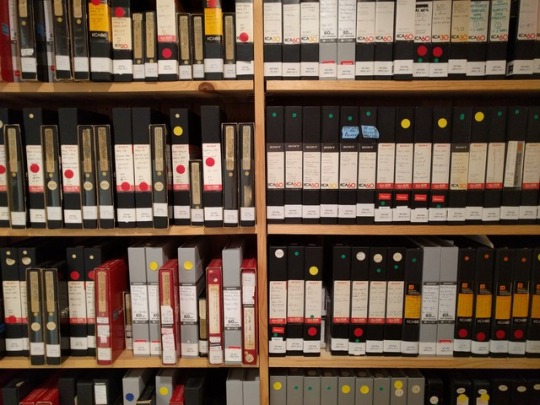
What are Archives and what can we do with them?
“Archives have the capacity to produce and reproduce social justice and injustice through their constructions of the past, engagements in the present, and shaping of possible futures” - Michelle Caswell and Marika Cifor [1]
The word “archive” has many meanings. Archive(s) can refer to a place, a repository where records are kept. Archives can refer to material, historical documents, personal and community belongings. To archive can be a verb, used to describe the transfer of records. Archives can refer to computer data. They can come in any shape or form and contain records of past actions so that we may reference them in the future. The concepts and definitions of “record” are constantly challenged and debated even within the archival profession.
Terry Eastwood states “the roots of archival theory may be traced to certain ancient legal and administrative principles. In order to conduct affairs, and in the course of conducting affairs, certain documents are created to capture the facts of the matter of action for future reference, to extend memory of deeds and actions of all kinds, to make it enduring” [2]. Archives can be considered monuments to the past because records were produced by specific entities during their activities under certain conditions. They can therefore attest to those recorded “acts” and “facts”. It is because archives provide an unbroken chain of custody, in a protected setting where corruption or falsification is difficult, that they can be deemed trustworthy and reliable.
The concept of archives and records being trustworthy and reliable is deeply important for the idea of evidence and the demonstration of accountability. We can hold people, corporations, and governments to account by exercising our right to view information produced by them to confirm that they act how they purport to act. This can be an important tool in rendering social justice, exercising rights, and maintaining fiduciary trust. We can see how people, corporations, and governments deny transparency by destroying, restricting, or simply not producing their records. We see this in the BC government’s intentional deletion of emails relating to the Highway of Tears, the US government’s unethical disregard for the Standing Rock Sioux Tribe’s treaty rights spelled out by the Fort Laramie Treaty, the memorandum released by the National Archives and Records Administration (NARA) of the US stating that the records produced by the then President-elect’s Transition Team (PETT) will be considered private and restricted instead of being publicly available as they usually are [3][4][5].
Archives as evidence can have powerful outcomes for those who utilize them in legal affairs. But, the conceptual stillness of archives as evidence does not always represent the truth or at least not the whole truth. Documentary truths are not all truths. A document that is accurate, as in, it is produced by and when it says it was created, does not mean it resides outside of the realm of human processes and intentions. Rather, it is an indication of those human processes and intentions. Archives can promote social justice and injustice, sometimes simultaneously.
Archives are contingent on the nature of their creation, preservation, and dissemination. The criteria determining each set of actions and procedures is inherently historical, cultural, and political. Verne Harris writes, “an archive is a sliver of a sliver of a sliver of a window of a process” [6]. No archive preserves all the records of everyone, leading to inherent omissions from the public record and raising questions about who gets to decide what shall be saved.
Archives are select records decidedly put aside for future reference - a very small sliver of a complex result of context, narratives, and production. Rodney Carter writes “archival power is, in part, the power to allow voices to be heard… The power of the archive is witnessed in the act of inclusion… (but also) the power to exclude. Inevitably, there are distortions, omissions, erasures, and silences in the archive. Not every story is told” [7].
Community archives are an extremely important infrastructure and public service to the community it serves and more. When large or institutional archives fail to represent communities who are marginalized by race, class, sexuality, gender, and politics, communities themselves will often create their own archives outside the boundaries of the formalized institution. Often, with the grassroots labor of devoted volunteers and limited staff. These valuable community archives come in many forms and can counteract the way their community is represented by the mainstream archival, historical, political, and social discourse. Communities can include artist-run centres, LGBTQ+ initiatives, racialized peoples, independent collectors with specialized interests, religious centres, geographic and/or rural communities, cultural associations, political and activist movements, and survivors of atrocities. Creating an archive can then become a political and reflexive act; by constantly repositioning collecting and descriptive strategies with the needs of the community in mind, archives can be used as a means to empower and construct one’s own identity.
Archives themselves are not necessarily powerful, it is how they are created, used, and received by people that is powerful. They are meaningful extensions of human interactions that allow or deny histories and futures. Archives should be “activated” by being used, promoted, and questioned.
Text
Anna Tidlund
Notes/Sources
[1] Michelle Caswell and Marika Cifor, “From Human Rights to Feminist Ethics: Radical Empathy in the Archives”, Archivaria 81, Spring (2016): p. 26.
[2] Terry Eastwood,”What is Archival Theory and Why is it Important?”, Archivaria 37, Spring (1994): p. 125.
[3] The BC Liberals staffer, George Steven Gretes, was fired and charged with wilfully making false statements to mislead, or attempting to mislead, under the Freedom of Information and Protection of Privacy Act. The crime led to the publication of Investigation Report F15-03 Access Denied: Record Retention and Disposal Practices of the Government of British Columbia that champions for The Duty to Document. The investigation was lead by Elizabeth Denham, Information and Privacy Commissioner for BC (now the Information Commissioner of the UK).
[4] In 1851 the (colonial) Treaty of Fort Laramie “legally” asserted that Standing Rock Sioux Tribe owned land, including the land west of the Missouri river. Shortly after the Treaty was signed, white settlers began to encroach further on Indigenous lands, sanctioned by the US Government without tribal approval. This disregard for Indigenous peoples and their rightful ownership to land was further provoked in 2016, when the U.S. Army Corps of Engineers granted authorization to the Dakota Access Pipeline without tribal consultation.
[5] On November 16, 2016 the National Archives and Records Administration (NARA) issued public memorandum AC09.2017 stating that the Donald Trump’s (then) President-elect Transition Team (PETT) would not be considered Federal or Presidential records, but private materials. The result is that NARA is not required to collect or preserve records created by the PETT, denying access to these records for future reference.
[6] Verne Harris, “The Archival Sliver: Power, Memory, and Archives in South Africa”, Archival Science 2, (2002): p. 84.
[7] Rodney Carter, “Of Things Said and Unsaid: Power, Archival Silences, and Power in Silence”, Archivaria 61, Spring (2006): p. 216.
Image
Photo by Anna Tidlund, taken at the Western Front’s Videotape Archive (2016).
0 notes
Photo
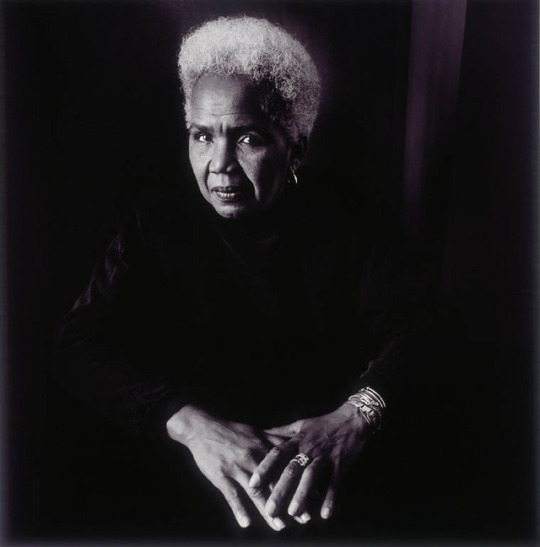
“A PROVOCATIVE SPEECH” by Rosemary Brown
Rosemary Brown (b. 1930 Kingston, Jamaica), the first black woman appointed to a provincial legislature in Canadian history, was elected MLA of the Vancouver-Burrard riding in 1972. Three years later, Brown would make her bid to run as federal leader of the NDP party—another first for a black woman in Canada. Ed Broadbent went on to take the party’s helm, but Brown came in close at second place with 41+% of the votes on the fourth and final ballot [1].
A woman who once said that to “be black and female in a society that is both racist and sexist is to be in the unique position of having nowhere to go but up,” Brown consistently worked to deconstruct conventions of oppression [2]. Among other initiatives, Brown “formed a committee to eliminate sexism in school textbooks and curricula...was instrumental in introducing legislation to prohibit discrimination on the basis of sex or marital status,” “was a founding member of the Vancouver Status of Women” and advocated tirelessly for people of colour in Canada [3][4][5].
She was also a popular speaker and a prolific writer. The UBC Rare Books and Special Collections archive hosts a number of files with original, typed speeches, all of which are passionate, insightful, and eerily prescient. With the 2017 provincial election on the horizon, one speech, given to the Alberta NDP party on May 7, 1976, feels particularly worth revisiting.
For context, 1976 was a year in which many of B.C.’s left-leaning voters were experiencing, what Brown called, “a widespread disillusionment” [6]. Four years prior in 1972, the New Democratic Party was elected as British Columbia’s provincial government for the first time since the party’s inception in 1933. This was a historical moment; the Social Credit Party had maintained control over the province for the last twenty years [7]. Despite the fact that the NDP had passed an extensive amount of progressive legislation during a short period of time, the run was short lived. NDP leadership lasted for a single three year term before returning to a Socred government in 1975.
Titled “A PROVOCATIVE SPEECH FOR ALBERTA NEW DEMOCRATS,” Brown’s speech addresses the swift return of B.C.’s conservative politics, the crisis of electoral disillusionment, the portentous death of capitalism (or at the very least, the incurable ailments of capitalism), and gives a critique of everyday life which suggests how to refute the aforementioned sources of despondency. Below are a few excerpts of this timely speech; the full transcript (for research use only) can be found here: https://goo.gl/9KxM8i [8].
A PROVOCATIVE SPEECH FOR ALBERTA NEW DEMOCRATS
On Alberta and British Columbia politics:
“It was not long ago that many Alberta New Democrats believed that the ‘grass was greener on the other side of the Rockies.’ The struggle for democratic socialism in Alberta seemed almost insurmountable in the face of the powerful oil corporation Tories…Many of you looked enviously at our NDP Government’s provisions for the elderly, at our willingness to assert the public stake in valuable mineral resources, forest products, and to preserve our scarce agricultural land…
Well, now we both know differently. The illusion has been shattered. The grass is not greener on the other side of the Rockies anymore.” [9]
On voter disillusionment:
“The illusion has been shattered.
The illusion that one successful election, one vigorous period of progressive legislation, can turn history around, can solidify and consolidate the aspirations of generations of socialists...But if illusions have been shattered, what has replaced those illusions may be even worse:
There is a widespread disillusionment, a feeling of despair, of cynical acceptance of what is, as being what must be. Of course on the Right this cynical disillusionment is almost welcomed as being a ‘liberating’ force, as a way of re-asserting the ‘good old days.’ A demoralized people is easier to divide, easier to coerce, easier to tempt with delusionary solutions. On the Left this mood is expressed in a pessimism, a fatalism about the chance of progress...This mood is more frightening than the ‘event’ of an electoral defeat.” [10]
On how to assess our complicitness in systems of capitalist oppression:
“We must look at our everyday conditions of existence and separate those aspects which really leave the quality of life untouched, those things which render life utterly banal…from those areas of life which have real quality, which make life worth living.
We must learn to recognize which of the supposed ‘benefits of the system’ serve real needs, and which only serve to oppress us…
We must assess our relation to the external world—and learn to separate real communication, real ideas, real events from mere side-shows and spectacles designed to blurr [sic] our vision…
We must investigate those aspects which break down social and political relationships, which tear us away from one andother [sic], which prevent us from struggling more effectively together…
We must recognize that the purposes of the capitalist system are not those of our own…
We must criticize our own ‘silence’, because this silence coincides with a fatalistic perspective which hinders action.” [11]
On strengthening socialism to strengthen reform:
“...it is clear that politics as opposed to parliaments develops outside legislative chambers, it develops in the needs, aspirations, struggles, and organizations of the people. Whatever our parliamentary goals, our political roots are out among the people.
Economic crisis, the capitalist crisis...cannot produce willy nilly a revolt. Capitalism has been ready for burial for a long long time. Cy Gonick tells us “a central fact of our own experience is the enormous strength and stability of civil society even when state pwoer [sic] momentarily falters.” It is not enough to know the system is breaking down. We need an alternative view, which challenges the totality of the existing structure...and that is not simply a matter of changing laws, and that is not found inside statute books.
Therefore I suggest that the NDP, political people, we cannot confine our struggle to electoral politics. We found in B.C. that merely legislative reforms did not make lasting changes or ensure re-election. Good legislation is not self sustaining. What we needed to do was to make good legislation defensible by the people—regardless of which party controlled the government legislation services. It is time for socialism to sink its roots more deeply into society, to find nourishment and support. When we do that, we will have the kind of policies and laws which cannot be so easily toppled, and that no government would dare to tamper with.” [12]
Upon retiring from politics in 1988, Brown continued her advocacy through organizations such as the MATCH International Women’s Fund—for which she was the CEO between 1988-91—and the Ontario Human Rights Commission of which she was named the chief commissioner in 1993. Among other national and international recognitions, Brown was the recipient of a total of 15 honorary doctorates from Canadian universities, the Order of British Columbia (1995), and the Order of Canada (Officer, 1996) [13]. Rosemary Brown passed away on April 26, 2003 in Vancouver, B.C..
Text
Introduction by Alexandra Bischoff
Speech excerpts by Rosemary Brown
Notes/Sources
[1] "Rosemary Brown (politician)." Wikipedia. Wikimedia Foundation, 30 Apr. 2017. Web. 02 May 2017.
[2] Hume, Stephen. "Canada 150: Rosemary Brown, an Outspoken Pioneer for Women of Colour." Vancouver Sun. N.p., 05 Feb. 2017. Web. 02 May 2017.
[3] "ARCHIVED - Celebrating Women's Achievements (Rosemary Brown)." Library and Archives Canada. Government of Canada, 10 Oct. 2000. Web. 04 May 2017.
[4] Snyder, Lorraine. "Rosemary Brown." The Canadian Encyclopedia. N.d. Web. 02 May 2017.
[5] For an example, we recommend reading a speech Brown gave in September 1982 to the Association of Black Business Persons titled “Motivation of Young People.” UBC Rare Books Special Collections; Rosemary Brown fonds; reference code: RBSC-ARC-1077-35-7.
[6] “A PROVOCATIVE SPEECH FOR THE ALBERTA NEW DEMOCRATS.” UBC Rare Books Special Collections; Rosemary Brown fonds; reference code: RBSC-ARC-1077-35-6 Alberta NCP “Disillusionment” 7 May 1976. Quoted from page 4.
[7] "List of British Columbia General Elections." Wikipedia. Wikimedia Foundation, 04 May 2017. Web. 03 May 2017.
[8] Courtesy of UBC Rare Books Special Collections; for research and reference purposes only. “A PROVOCATIVE SPEECH FOR THE ALBERTA NEW DEMOCRATS” by Rosemary Brown. UBC Rare Books Special Collections; Rosemary Brown fonds; reference code: RBSC-ARC-1077-35-6 Alberta NCP “Disillusionment” 7 May 1976.
[9] “A PROVOCATIVE SPEECH FOR THE ALBERTA NEW DEMOCRATS.” UBC Rare Books Special Collections; Rosemary Brown fonds; reference code: RBSC-ARC-1077-35-6 Alberta NCP “Disillusionment” 7 May 1976. Quoted from page 1.
[10] Ibid. Quoted from page 4.
[11] Ibid. Quoted from pages 14-16.
[12] Ibid. Quoted from pages 17-18.
[13] Snyder, Lorraine. "Rosemary Brown." The Canadian Encyclopedia. N.d. Web. 02 May 2017.
Image
Credit: Barbara Woodley, Labatt Breweries of Canada, Library and Archives Canada, 1993-234, PA-186871 Restrictions on use: compulsory mention: acquired with the assistance of a grant from the Minister of Communications under the terms of the Cultural Property Import & Export Review Act
#bcpoli#bc election 2017#rosemary brown#feminist politics#feminism#female leaders#black feminism#women in politics#bc politics
0 notes
Photo
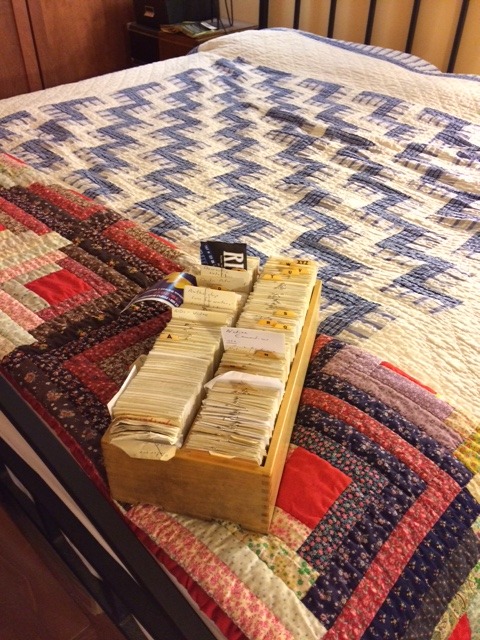
Ron Dutton and the B.C. Gay and Lesbian Archives
The following is a brief profile on Ron Dutton, founder of the B.C. Gay and Lesbian Archives. On February 14, 2017, Alexandra Bischoff and Anna Tidlund visited Dutton to ask him a few questions about his archival process, and to see the massive holdings which the archivist has been collecting since 1976. All quotations are of Dutton from this initial interview.
The B.C. Gay and Lesbian Archives (BCGLA) is unlike most archival institutions. One of its most distinguishing features is that the archives are housed within the founder’s apartment in Vancouver’s West End. Files are meticulously boxed and stored in the apartment’s guest bedroom, so there is an immediate sense of warmth, comfort and refuge offered not only to the visiting researcher but also the documents themselves.
Ron Dutton, the magnanimous figure behind the project, welcomes interested parties into his home, sits down with them at his kitchen table, and works through the vague inquiries that people often begin their research with. He tells us that while he hosts researchers of all kinds, they usually fall under four categories: fact checkers from the media, academics from across North America, cultural workers looking for inspiration, or individuals creating personal projects about family members.
For forty-two years, Dutton has worked to collect ephemera of B.C.’s queer communities. I ask him what major events can be found in the archive, to which he replies, “everything. I don’t make assumptions that something is too trivial to be collected. I collect everything.” The archive covers, he elaborates, anything B.C. and queer community related. His collection of around 750,000 items includes books by B.C.’s queer authors, magazines, newspapers, the newsletters of queer organizations, small publications (“that you would never find on the internet”), event ephemera, personal diaries, photo albums, audio cassettes, CDs, VHSs and DVDs, posters of all sizes, and government reports—to name a few.
There are many hidden gems. Tucked in one section are over 100 VHS tapes of drag shows at the no-longer operating Dufferin Hotel. Dutton sets the scene: grainy video of the 1970s and 80s capturing a smoke filled bar, drunken commentary cutting through the audio of a bad sound system, mixed with pure, drag magic. These tapes document hours upon hours of renowned performers (like Wanda Fuca and, pictured below, Adrian Alexandria de Vander Vogue) showcasing some of their best material.
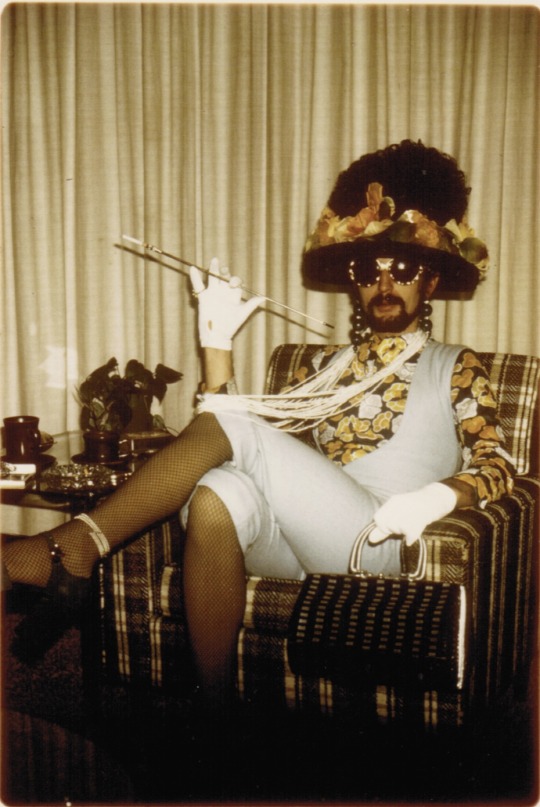
Dutton grew up in a small town in rural Alberta and went to the UofA for Library and Archival studies. The air in the 1970s, he recalls, was electric. According to Dutton, a fundamental difference between the 1970s and the 2000s is todays lack of optimism—or perhaps the overabundance of it in back then.
He notes that the broad theme of the 1960s belonged to “people who had been held down [by systems of oppression] and were not willing to take the abuse anymore.” The radical, anti-colonial protests resulting from WWII, as well as the Civil Rights and Women’s Rights movements worked to create a rhetoric around oppression that previously did not exist. This newfound vocabulary made it possible to verbalize the cruelties perpetrated against gay and lesbian people, propelling the Gay Liberation movement into the public sphere for the first time.
Because gay and lesbian communities in North America have historically been so vulnerable to judicial and societal violence, most of Dutton’s holdings represent queer culture from the 1960s onwards. A necessary quietude—the survival tactics of living under-the-radar, and even in denial of one's sexual or gender identity—means that Dutton’s most difficult task as an archivist has been to “work backwards” to uncover materials that describe the lives of queer people living in the 1950s and earlier.
One particularly unique case comes from an unlikely source. The Spanish Mapmakers of the 1730s, who travelled to document the coast of British Columbia, made several notes in monarchy-mandated journals about “cross-dressing” Indigenous peoples. More important than the discovery of men wearing “dresses” or women wearing “men’s clothing” was the discovery that these individuals were fully integrated and respected in society; whether they had same sex partners or held working positions typically associated with different sexes, people who identified as Two-Spirited were not outcast from their communities.
Dutton understands that certain groups have traditionally been written out of history. While the Spanish Mapmaker’s diaries have been studied extensively since the 1730s, for example, any notations therein about Two-Spiritedness were largely ignored. Even within the Gay Liberation movement itself, media representation in the 1970s generally showcased white, middle class activists. This is why Dutton has gone to extra lengths to make sure that the BCGLA offers as equal a representation as possible for all queer people.

Because Ron Dutton is ultimately committed to “bringing home” the individuals whose narratives the archive keeps alive, he regularly speaks at schools. He wants to connect with queer youth, who have grown up in a fundamentally different culture than he did. To see “gay politicians, musicians, and cultural icons” on television is something that Dutton did not experience in his childhood. He finds that young people have a great desire to know who came before them, and to hear what struggles their predecessors went through.
The elderly, on the other hand, have a more difficult time accepting Dutton’s claim that they have anything meaningful to contribute to the conversation—that they are, inherently, of historical and societal value. Again, due to the survival tactic of silence, queer seniors who lived through the 1940s and 50s can sometimes still be self-censoring. Dutton is patient, realizing that the stories of these individuals will be told and honored when they themselves are ready. With much sincerity and a depth of sensitivity, he tells us that he has a habit of combing through obituaries for mentions of “fond memories from the ‘special friend’” of the deceased. He will collect these notices and add them to the archive, knowing that he is bringing them home; the archivist wants “them to be where their heart was.”
I asked Dutton if he had ever imagined that the archive would become so expansive. He laughed and said, “If I had any idea, I would have been so intimidated I probably wouldn’t have even started.” The position has grown to be so substantial, and Dutton has been gifted so many collections of files and ephemera, that the task of stewardship has become a lifelong endeavour. “I have adjusted to match the needs that the job entails,” he tells us. A task this monumental requires a person with the fortitude to equal that of the archive’s holdings; by all accounts, Dutton is up to the challenge.
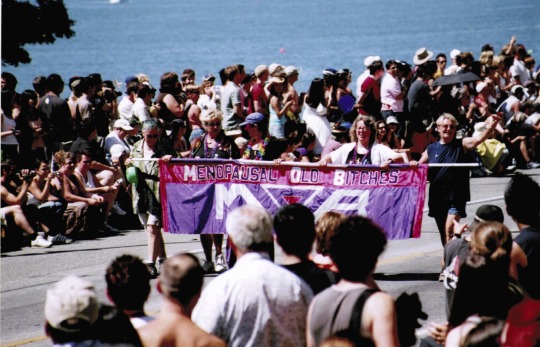
To visit the B.C. Gay and Lesbian Archives, email Ron Dutton to make an appointment: [email protected]
Alexandra Bischoff and Anna Tidlund would like to express our gratitude to Ron Dutton for offering us such a candid view into his life and work.
Text
Alexandra Bischoff
Images
Courtesy of Alexandra Bischoff, a BCGLA finding aid in-situ, 2016.
Courtesy of Ron Dutton, photo of Robert Pogue aka Adrian Alexandria de Vander Vogue, 1972.
Courtesy of Ron Dutton and Imtiaz Popat, photo of activist Imtiaz Popat and Salaamat during the Vancouver Pride Parade, 2010. Salaamat has since become Salaam-Vancouver when it joined the Salaam Canada: Queer Muslim Community coalition.
Courtesy of Ron Dutton and Pat Hogan, photo of the Menopausal Old Bitches (M.O.B.), Vancouver Pride Parade 2006.
#queer activism#vancouver lgbtq#queer archives#creative protest#art and archives#vancouver pride#vancouver drag#queer muslims#menopausal old bitches#vancouver#BC gay and lesbian archives
1 note
·
View note
Photo

Corporeal Returns: Feminism and Phenomenology in Vancouver Video and Performance 1968-1983
Text by Marina Roy
First Published in Canadian Art, Toronto, Summer 2001.
Scene: September 1975; Vancouver Small Claims Court; Diana Douglas in the witness box after being sworn in by the judge.
Judge: Your name please. Douglas: Diana Douglas. Judge: Miss or Mrs.? Douglas: Ms.
Judge: Pardon?
Douglas: Ms ... M...S...
Judge: What does that mean?
Douglas: It means that I feel that it is not relevant whether I am married or not. Judge: Um...You mean you are a nonentity...
From a distance of over twenty-five years, it may seem hard to believe that this scene between a judge and a citizen occurred during International Womenʼs Year, at the height of the womenʼs movement. For a representative of the law to say that women were either Miss or Mrs. and nothing in between, underscores the limitations put on womenʼs roles within society and the problem of symbolic domination that women had to contend with. A womanʼs social role had traditionally been defined in relation to that naturalized institution, the family. Foucault tells us that “juridical systems of power produce the subjects they subsequently come to represent”. The judgeʼs use of the word “nonentity” is significant in terms of the phenomenological issues that were being discussed within various cultural fields at the time — the idea that oneʼs body was an experiencing entity in-the-world. The juridical projection of “nonentity” onto Douglas uncovers deep-seated essentialist views. Cultural law projects readymade feminine attributes onto women, then somatizes them as a “metaphysical substance” inherent to “woman”.
When women attempt to shed these social fabrications, performing roles as subjects rather than objects they are disrupting the sexual division of material life, the very stuff on which the political economy of capitalism is based. This disrupts the repetitive flow of day to day collective social habits. According to Judith Butler our identity is constructed temporally by repeated and ritualized performative acts, a reenactment of a set of meanings already socially established and simply reproduced as natural: “If gender is instituted through acts which are internally discontinuous, then the appearance of substance is precisely that, a constructed identity, a performative accomplishment which the mundane social audience, including the actors themselves, come to believe and to perform in the mode of belief. If the ground of gender identity is the stylized repetition of acts through time… then the possibilities of gender transformation are to be found in the arbitrary relation between such acts, in the possibility of a different sort of repeating, in the breaking or subversive repetition of that style” (Theatre Journal, vol.40, p. 519).
In the 1970s many women artists in Vancouver were practicing this “different sort of repeating” using various performative strategies within video and performance art. These strategies were in many ways an extension of the spirit of the times. Theories of language and communication (e.g. Searleʼs performative speech acts) and phenomenology (Merleau Pontyʼs lived experience and his placing of the body at the centre of experience) were based on the idea of sentient agents acting within a socially- constructed environment. Simone de Beauvoir also used a phenomenological approach in her feminist classic The Second Sex . The days of Cartesian subjecthood, as psychically transcendent, divorced from the physical body, and epitomized in Western art by abstraction, essence, and genius, were beginning to recede into the modernist past. Lived experience was founded on the corporeal. The separation of all fields into essential categories was being deconstructed and reconfigured. The traditional division of labour on which heterosexual relations were enforced and naturalized, crumbled as women sought agency outside the confines of the domestic sphere, the family unit.
In Vancouver, from about 1968, the new media of performance and video art were developing at the same time as the feminist movement and the beginning of artist-run centres. Within these centres one had free access to equipment and studio space, and found oneself part of a supportive community of artists practicing divergent disciplines. For one of the first times in history, many women found an alternative space to that of the home where they could live and work as artists. Collaboration meant the cooperation of bodies performing within a communal space, but it also meant taking part in an international network, as with correspondence art and video distribution networks. Funding for these collaborative ventures was increasingly provided for by the Canada Council. Also in 1968, the CRTC was instituting community access cable programming, thus signalling for many artists, the possibility for a more inclusive distribution of information and cultural expression.
It may seem paradoxical that such a heterogeneous array of media and agents should have come together at the same time to form such unparalleled opportunity for artists in Vancouver. A body-centred art practice worked in tandem with new forms of technological reproduction (video), avant-garde artists often found support from the cultural establishment (the Canada Council, the Vancouver Art Gallery), and video artists sometimes had assistance in production and distribution from broadcast television (Cable Ten). Women artists were at the forefront of this new activity in the 70s. A particularly wide variety of communities, counter-cultural, and activist strategies were formed by, and made available to women . The 70s signaled a moment of historical rupture for society and culture. Not only were the categories of Miss and Mrs. torn asunder; so were those of traditional art practice, reception, and distribution. Although other cities in Canada could vaunt a similar cultural climate, Vancouverʼs social and cultural situation was unique.
The period covered here, from the late sixties to the end of the seventies has come to be known culturally as the “Canadian renaissance”. The success of Canadaʼs centennial celebrations, especially at Expo 67 in Montreal, gave the nation a cultural presence on the international stage, seen as excelling in the fields of technology and communications. The key national cultural institutions of the CBC, the Canada Council, the National Film Board, and Telefilm Canada were instrumental in forging a national identity in an attempt to unite a small population across a vast territory. Radical changes were brought about in the arts in large part due to the Canada Council (established in 1957), with its armʼs length distance from government intervention. Without access to such funding, work space and equipment would have remained inaccessible to artists wishing to experiment with new technologies and approaches to making art. The pressure to create marketable art works was alleviated by the presence of artist-run centres, opening the way for a more socially-engaged praxis. While most commercial galleries were still steeped in modernist paradigms, the artist-run centre began an investigation into interdisciplinary approaches to new and traditional media. The government encouraged the use of this new technology in the cultural realm, for it served to strengthen Canadaʼs image and reputation globally. The eventual institutionalization of artist-run centres and alternative community groups, set up through various funding programs, was also a way of keeping more activist, oppositional groups under wraps: “The lessons of the Roosevelt era in the U.S., which saw the absorption of the radical movements of the 1930s through meagre but widely accessible state funding, were not lost on the Trudeau government, itself a product of populism and the mass media” (_Vancouver Anthology_, p. 63).
Vancouver had always been isolated geographically, and it was only with increased air travel and broadcast communications that there was a turn toward a more national and global perspective. Vancouverʼs supposed lack of history, itʼs profoundly multicultural status stemming from a constant influx of immigrants, perhaps made people feel that there were fewer homespun traditions constricting their identity. People tended to come to Vancouver with an image in their minds of the last frontier, a land burgeoning with unlimited resources and opportunities, factories implementing the ideals of progress and innovation, not to mention its reputation as lotusland — a welfare and drug culture. One came for economic opportunity and a lifestyle. Because Vancouver was a peripheral city, not a centre in the modern sense of the word, it was very much at home with the idea of networking, incorporating innovative communications systems, as a way of keeping in touch with the world, in turn drawing the world to it. Its dispersed, elusive identity, and its new economy of “dynamic services” in the 70s, made it warrant the title of “postmodern city”.
The utopian impulse to blur the boundaries between art, life, and technology began in the early sixties when a new generation of artists was breaking away from the lyrical regionalism of landscape painting associated with Vancouver. In 1961, a giant leap into the international arena of art took place at the University of British Columbia, under the guidance of B. C. Binning and June Binkert. The Festival of the Contemporary Arts took place every February for the next 10 years (1961-71). These collaborative events included works by a host of prominent local, national and international artists and poets (mostly from New York and California: Cage, Cunningham, Halprin, Rauschenberg, etc.). The festivals were initially inspired by the “surge of postwar artistic energy first released by the abstract expressionists in New York” (Alvin Balkind), but in the end it was the anti-establishment practices of interdisciplinarity and experimental play that were de rigueur , in the areas of music/sound, poetry, dance, happenings, film, theatre, installation, etc. The festival acted as a catalyst for the emergence of a new kind of artistic praxis, of an international rather than regional or national character.
In 1966, a group of artists and architects, many of which had participated in the activities of UBCʼs art festivals, decided to create an artist-run centre where collaboration and new electronic media would signal the dawn of a new utopian consciousness. With some local financial support, and $40,000 from the Canada Council (the first artist-run centre ever to be funded), these artists bought film and electronic equipment and founded Intermedia in 1967. The space was essentially a democratic one, upholding an open door policy to anyone who wanted to experiment with multimedia. The first video portapak was introduced to Vancouver artists via Intermedia in 1968.
Without a doubt, the most important collaborative activities to come out of the late sixties were that between Intermedia and the Vancouver Art Gallery under the aegis of Anthony Emery and Doris Shadbolt. The VAGʼs Special Events programming and three consecutive years of Intermedia week-long festivals (1968-1970), were the principal venues for new explorations in performance art. It was one of the only spaces available where artists Gathie Falk, Evelyn Roth, and the Helen Goodwinʼs dance troupe could realize their performance works. Such visiting artists as Ann Halprin, Yvonne Rainer, Deborah Hay, and critic/curator Lucy Lippard were especially inspirational to these artists. The VAG and the Vancouver Public Library also played an important role in initiating and sponsoring womenʼs art events such as Women in the Arts that presented performances and discussions.
In 1968 Deborah Hay held workshops at the Douglas Gallery and Intermedia in what was then called “dance-oriented live performance”. Originally inspired by the Black Mountain College experiments and happenings from the 50s, Hayʼs workshops sought to incorporate body movements from everyday life into performance: “From my work with artists, I learned to appreciate the way non-dancers responded within the context of a performance. I never asked them to execute movements that they did not do in everyday life.” 1968 heralds the dawn of performance art as a discipline in its own right in Vancouver. Before this time, artists and dancers would experiment with sound, multimedia light shows and installations, more or less in an improvisational manner, without any solid idea except perhaps a McLuhanesque notion of global communication and counter-cultural communalism. Women had been taking part in these collaborative intermedia events, especially as dancers and poets, but they were often ignored and given second place within multimedia events. While collaborative performance was an alternative to and a critique of individualistic (male-dominated) modes of art production, this rarely meant that women were granted an equal place within that community. After Deborah Hay taught dance performance workshops in Vancouver a whole new direction was taken in performance-based works by women.
The use of repetition within these dance-related performances was directed toward creating a new type of audience participation. The process of performance was made transparent through the use of variations on repetition, as constitutive of the social rhythms of the body. The audience would relate to performers through their use of mundane movements and non-hierarchical relations between dancers. This type of performance would reflect the everyday lives of all members of the audience, implicating them in a non-hierarchical fashion. Bodies repeated the same actions so as to allow the audience to see these movements. The use of repetition also evokes what Judith Butler calls “identity instituted through a stylized repetition of acts”. In phenomenological terms, the body is displayed not only as being in-the-world, or as a sensuous and experiencing entity, but in a state of perpetual becoming: “The body is understood to be an active process of embodying certain cultural and historical possibilities… the acts by which gender is constituted bear similarities to performative acts within theatrical contexts” (p. 521).
Works performed by such dancers as Helen Goodwin and TheCo used everyday movements such as people slowly moving along a wall, or “dance” movements where each member would execute one of a number of separate activities in a continuous repetition: one person rolling themselves in paper, one person walking with sponges attached to their feet, another performing actions with an umbrella, etc. From the very start, Helen Goodwin had been very active within the UBC Festival for the Contemporary Arts and had been a founding member of both the Sound Gallery and Intermedia. Her work was in close collaboration with musicians and multimedia artists within these communities. The Anna Wyman dancers presented a more professional dance performance situation, employing everyday, repetitive movements within their dances, set to electronic music by modern composers such as Stockhausen. They also performed at the VAG during Intermedia festival events.
Evelyn Roth combined performance and video art in a thought-provoking way. Costume design is usually considered secondary to theatrical production or social life. Yet the sartorial displays social codes, setting up hierarchies between subjects. Through crocheting and donning videotape garments Roth came to embody a persona during the 70s. As a bag-lady-cum-fashion model, she somehow elevated the idea of being a mundane public media figure into the realm of art. She is best known for her performances in crocheting recycled video tape into garments, hats, car covers, gallery awnings. The action of covering bodies, cars, and buildings in used videotape could be construed as a comment on the technologization of bodies and spaces, our entrapment within the very medium of communication that we use to try to transcend our bodies. The use of crocheting within the context of art also placed value on womenʼs work.
One of the most acknowledged performance artists to have come out of this Intermedia/VAG collaboration was Gathie Falk. Her performances began within the context of Hayʼs workshops. Everyday, task-related activities and repeated objects played a central role in her artwork, signaling the repetitive nature of womenʼs domestic work and the fetishization of women into objects of desire.
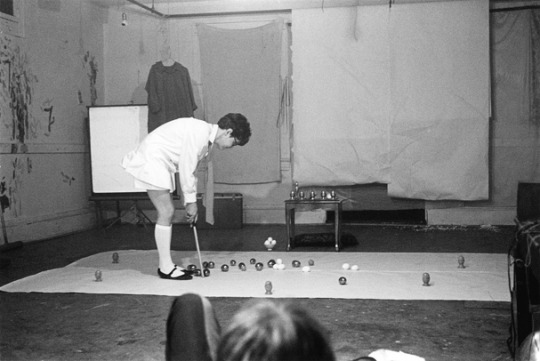
Falkʼs girl-child costumed persona (white blouse, pinafore, maryjane buttoned shoes) seems to reinforce the idea of masochistic entrapment that Falk within her work. Her use of eggs (with its references to fertility) is abject and disturbing in two of her performances: Eighty-eight Eggs (in which she is pelted with eggs by the audience) and Some are Egger than I (where she bats around ceramic eggs croquet-style until she hits a raw egg; by some absurd logic she then proceeds to eat a boiled egg; this action is repeated eight times). The impact of Eighty-eight Eggs as a performance relates to masochism: she is egged by the audience as if in reaction to a bad performance, and yet she performs nothing. This being egged “before the fact” becomes a statement unto itself, implying perhaps inadvertently that this is how women feel when they are discouraged from expressing themselves or put down publicly if they do attempt to play roles that are considered inappropriate to their nature. The slapstick nature of audience participation falls short of the mark, turning into pathetic spectacle.
Another example is Red Angel where a winged Falk sits atop a commode while five record players with ceramic parrots on them, do a musical round of “row, row, row your boat”. Falk herself repeats the same lines last. The idea of being a broken record, driven to repeat the same lines over and over like a parrot, reflects her role as woman trapped within the vicious cycle of repeated acts, as a woman passively displaying herself as a decorative ornament, repeating what she is taught to say. Once the musical round is finished, a woman wheels in a washing machine, removes Falkʼs gown, washes it, and then leaves the space. Falk then repeats the exact same opening sequence. The performance repeated a second time is however profoundly different. The repeated sequence speaks of entrapment. The angel follows the motion of a technologized controlled rhythm, just as womenʼs work is controlled by the technological rhythms of home appliances.
As a body-based art form, performance had its roots in early 20th century avant-garde art. In the 1920s (in Europe), and again in the 50s and 60s (in the U.S.), a type of ʻtheatricalityʼ formed itself in opposition to the modernist myth of the autonomous work of art, legitimized by the art institution, created by the male ʻgeniusʼ artist. The prototype was Picasso in Europe, Jackson Pollock in America. Amelia Jones in Body Art: Performing the Subject has pointed out that the fascination with Pollockʼs performative process of action painting, first seen in photographs from the late 40s and early 50s, was downplayed by theorists such as Greenberg. They emphasized product over process in the work. In reaction to modernist criticism, minimalist artists made work that Michael Fried characterized as degenerating away from art and moving toward theatre—what lay between the arts. Preoccupation with duration, whereby the beholder became implicated in the artwork, was considered anathema to formalist critics. In an ironic gesture pop art elevated mass media for the viewer. Subsequently, conceptual art elevated the philological notion of art as idea in the form of instruction sheets, card files, and even photographs of deadpan performative acts (or the result of these acts). These practices favoured the dematerialization of the object.
Video art and performance art by women could be seen in part as a culmination of, and a reaction against many of these strategies. (In many ways, one could see feminist strategies as one of the major vital forces behind postmodern turns in art.) The process-oriented, performative aspects of action painting, the inclusion of the beholder and of duration within the artwork, the dematerialization and ephemerality of the work, were elements that were retained from the art strategies of the 50s and 60s. But the preoccupation with formalism and information at the expense of figuration or the body was considered to be foreign to womenʼs experience. Having always been relegated to the status of immanence rather than transcendence in the Cartesian tradition of Western thought (transcendence/mind/male vs. immanence/body/female), women were relegated to the realm of the corporeal, weighed down by their biology. Thus the importance for many women of representing their bodies and life experiences within art works. One of the main reasons women turned to performance and video in the late 60s was that it was still uncharted territory. While men had made a history for themselves in the more traditional media of painting, sculpture, film, and photography, video and performance was so new that women felt they could truly make the medium their own, make it speak for them without the historical baggage of male precedence.
The chief social reaction to the end of the war in the 1950s, a time of unparalleled economic wealth arising from a war-fuelled economy, was a soaring marriage and birth rate. Family became a sacrosanct institution. In Canada, as in the U.S., television was to become the ideological channeller of such a vision: “Members of the Fowler Commission viewed television as a unifying source for the rejuvenation of family, serving as a headquarters, a gathering place, enhancing family encounters in the home and strengthening the moral fabric of the nation… what was striking about this focus on the family was not only the reification of the home as the source of moral order, but the way in which television was contextualized as a fixture not of community, nor of the individual, but of the family unit” (Dot Tuer, “Family: An Examination of Community Access Cable in Canada”, Fuse , Spring 1994, p. 26).
By the 60s a new strain of ideology, in the form of the movie star, the rock star, the media icon, and artist genius, touted individualism as the religion. Given the socializing influence of television, distortions of reality determined how people perceived themselves and one another. The coincidence of the sixties generation with the media culture boom meant that youth developed a narcissistic relationship with new archetypal role models. As the hegemonic structures of broadcast and press information began to belie their morality and truth-value, artists took Marshall McLuhan at his word and took on the role of “perception experts” and “educators of the future”. Videoʼs phenomenology, its format and its inherent “real time” aesthetic, connects it to television. For this reason, using video as a new form of global media, became a way of expressing disillusionment with televisionʼs biased, manipulative nature.
One of the great advantages of video was its reproducibility, exchangeability, “synced audio-visual portability, low-cost reusable tape, and instantaneous record and playback capabilities” (Paul Wong). The medium was very much in tune with the times, with the idea of a free-floating distribution system of ideas dashing across the globe, setting up a network of collaborative projects by artists made through the process of exchange (mail art), of special interest groups not bound by the strictures of space and time. Performance and video artists fought against the alienating effects of television in two ways: through ironic posturing and through social-activism.
1973 was an extraordinary year for video art in Vancouver. There was the Matrix conference that gave rise to Video Inn/Satellite Video Exchange Society (through the donation of 120 tapes by artists who partook in the Matrix conference); the Pacific Vibrations Exhibition at the VAG showcased video and performance works; the Womenʼs Film and Video Festival gave rise to Reelfeelings, a womenʼs film and video collective. It was also the year that the Western Front came into being. That year a group of artists found themselves homeless thanks to the razing of old buildings to make way for new more expensive ones. Rents had also been hiked and they were looking for housing alternatives. Needing a home and studio space, and no doubt inspired by Intermedia and New Era Social Club, not to mention the Maplewood Mudflats community in Dollarton, these artists came up with the idea of pooling their money together and establishing a communal living space. Founding members Michael Morris, Vincent Trasov, Kate Craig, Eric Metcalf, Glen Lewis, Mo Van Nostrand, and Henry Greenhow set up the Western Front. Unlike previous artist-run centres, the Western Front was much more selective in terms of the facilitiesʼ conditions of use. Equipment and studio space was reserved for themselves, select friends, and artists-in-residence.
Fluxus type activities began when Image Bank was formed, a mail art network inspired by Ray Johnsonʼs New York Correspondance School of Art. In keeping with the latter activities, Western Front artists took up pseudonyms and personae that stuck with them for years: Dr Brute and Lady Brute, Mr. Peanut, Flakey Rose Hip, Marcel Idea, etc. These in turn became future roles within cabaret events. This use of “larger-than-life” media-style personas was at once playful and critical inspired as much by Dadaist strategies of the 1920s as by the glamour stereotypes of mass media. The use of pseudonyms was based on the fantastical idea of being able to change life into art or rather, art into lifestyle. It was also a comment on the facticity of the so-called norms of identity tailored to everyday life as produced under capitalist modes of production.
The construction of personas was also very much about liberating oneself from the strictures of nationhood and geography. Creating a new persona and being known as that persona had a somewhat tribal or totem-like ring to it. Demarcating oneself from the status quo became a political statement steeped in irony. It signaled being part of a different tribal community, one bound by relations other than kinship ties. For women it was a way of criticizing the structure of the normative family relations. Community and public agency were seen as breaking the bipolar categories of home/work, private/public, husband/wife, life/art. Trapping oneself within a persona was about breaking free from this socially-regulated somatized prison.
These extravagant high camp gestures were thus based on a will to form a community outside of the usual roles of daily life, they literally wanted to unmask the alienating effects of traditional roles on everyday life. By making their lives a public spectacle, they were also becoming fictional embodiments of cliched glamour images, parodying the ubiquitous Hollywood and TV star. Being a West Coast city, Vancouver quite naturally has a cultural dialogue going on with a place like LA. The Western Front participated in (and the Image Bank helped organize) the Decca Dance in Hollywood in 1974. It was a parody of the Academy Awards that attracted hundreds of performance artists.
Kate Craig organized the Western Frontʼs video production studio in 1976. In 1977, she established and curated the Artist-in-Residence Video program. Her strong administrative role within the society, her leading role in video production, and her prominence as a performance and video artist in Vancouver, all contributed to the formation of a strong presence of local, national and international women artists at the Western Front. Some of the women who have been more directly involved with the Western Front over the years have been Jane Ellison, Daina Augaitus, Elizabeth Vander Zaag, Karen Henry, Annette Hurtig, Susan Milne, Babs Shapiro, Cornelia Wyngaarden, Elizabeth Chitty, Margaret Dragu, Mary Beth Knechtel, Judy Radul. Craigʼs performance of Back up in collaboration with Margaret Dragu, reflects a panoply of activities and narratives, gender stereotypes, and new roles enacted by women. Without being overtly political, they play out the lifestyles of school girls, pool-hall tough girls, scientists, upper- class debutantes, and domestics.
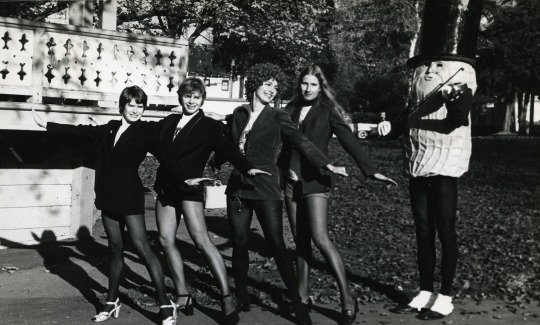
This mercurial role-playing reflects Craigʼs inclination towards adopting quite a variety of personae in her art-as-lifestyle. She was one of the Soni Twins, one of the ʻEttes, and at one point she identified herself with the colour pink (via an extensive pink wardrobe). Her most lasting alter-ego however was Lady Brute, a female stereotype based on leopard- spotted accoutrements. In her own words, Craig says that: “Lady Brute was...very much a part of Dr. Brute, a collaboration with Eric Metcalfe in terms of our marriage and our lifestyle together. Lady Brute was a mask, a point of focus, where you could step one pace behind and use it in a very specific way without necessarily becoming that person...One of the wonderful things about Lady Brute was that there was a stand-in at every corner. If I wore the leopard skin it was only to become a part of this incredible culture of women who adopted that costume”.
Craig based at least two videos on her persona Lady Brute. Through the Image Bank mail-art directory she acquired a huge collection of leopard skin paraphernalia and garments. The fashion statement associated with faux fur and mimetic animal patterning seems to signal female aggression and animal sex drive. As a sign-system it serves to mask the alienating effects of the colonization and exoticization of the female body, grounding it in a reversal of predator/prey fantasy. In the video Skins (1975), Craig documents herself modeling her Lady Brute wardrobe. She dresses and undresses in front of the camera, taking on different poses and stereotyped attitudes for each costume. The female stereotypes named in the video soundtrack describe the type of woman Craig becomes in each new outfit. Her multiple incarnations as Lady Brute underline the parodic nature of the video, as it traces out the many fantasy construction that dominate womenʼs lives.
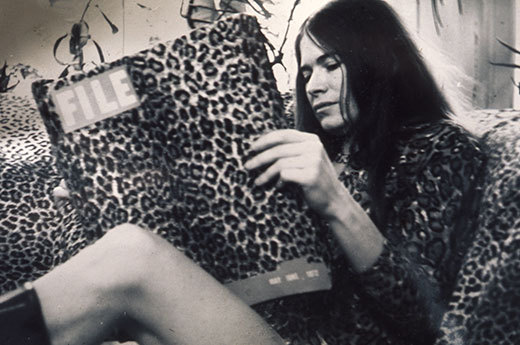
Craig was also involved in collaborative performances as one of the ʻEttes, an all-women song and dance group. During the Mr. Peanut 1974 mayoral campaign, this group of women were cheerleaders, playing out the adolescent fantasies of being symbols of reward or “objects of pleasure” associated with sporting events. Their presence on the political scene cast an absurd light on the mayoral campaign, where the electoral process became framed as little more than a game performed by aristocratic nuts out to score the most points, based on the best rhetoric and spectacle value. The ʻEttes included Mary Beth Knechtel, Suzanne Ksinan, Lin Bennett, Babs Shapiro, Helen Tuele, Judith Schwartz, Barbara Best and other guests. They also came together as the Cocanettes and Infinettes at A Space in Toronto, and as the Vignettes for a media-hype style performance for the Amy Vanderbilt Debutantes Ball . The scandal surrounding Amy Vanderbiltʼs death inspired this performance and ball. Later on a lot of the same and some new members, came together to form the Girlʼs Club. They would get together for informal womenʼs meetings over dinner when visiting women artists came to town. At other times they would turn out for media events. This coming together of individuals into loosely formed collaborative groups reflected a certain optimism and real community spirit. Spontaneous performances in a wide variety of public contexts could affect people in unforeseeable ways, for instance, as when the 1974 Mr. Peanut won 2,685 votes in the mayoral campaign. Working collaboratively meant that no one person would steal the show.
Early video has often been denigrated by mainstream factions using such epithets as dumb, boring, narcissistic, lewd, badly made (Jan Peacock, Video Re/view, pp. 144- 160). This had much to do with the nature of early video technology and budget constraints. Content was quite often privileged over form. A raw aesthetic certainly conveyed its own message—”this is not TV; this may even be critical of TV; this is presenting something that TV would never show you”. Most artists working in video wanted to counter the seductive aesthetics of television that catered to a mass audience. A lot of early videotape was used in a documentary fashion, as a way of spontaneously recording the surge of unprecedented artistic collaboration going on at the time. Documentary was also the medium of choice for works made by activists, feminists, and community groups in conjunction with cable programming, education and consciousness-raising being the focus.
In 1973 the Matrix International Video Exchange Conference/Festival was organized by Michael Goldberg, Patricia Hardman and Noelle Pelletier. The condition of admission to the conference was the donation of a favourite videotape. This in turn, became the foundation for the Video Inn library and the Satellite Video Exchange Society. This was meant as a way of setting up a global network of communication between artists and communities and was a reaction against the centralized mass media of broadcast television. As one of the first major international video conferences, Matrix attracted some of the most prominent video artists in the field. Unlike the Western Front Society, Video Inn (known as Video In after 1987) members were committed to social activism and education through the uses of video as a communications and information medium. Like the Western Front however, it had an “almost familial structure” (Diamond, p. 56) and in the early years collective dinners were a par for the course. The strong presence of women (Renee Baert, Shawn Preus, Jeanette Reinhardt, Barbara Steinman, Peg Campbell, etc.) meant that there was much collaboration with womenʼs groups in putting on the Womenʼs Arts Festival (1974), Conceptual Womenʼs Art Tapes from Europe, Japan and North America (1975), Women and Video Art (1976), Rape (1977), Video Inn Womenʼs International Exhibition (1977 & 1978), Feminist Tapes (1979), Womenʼs Media Nights (1979-1985). At Video Inn the equipment department and workshops were also largely run by women, signaling a strong feminist presence that attracted women artists to the medium.
Unlike film, video provided a more immediate form of expression and greater distribution possibilities for women. At a time when “spreading the word” was essential to the strengthening of womenʼs positions within society, video provided a fast and somewhat inexpensive means for doing this. Many of the women associated with Video Inn made tapes that dealt directly with womenʼs issues. Peg Campbell made many videotapes about wife battering. A Rule of Thumb (1977) for instance refers to the Common Law Doctrine that, until 1897, “allowed a husband the right to beat his wife provided he used a switch no bigger than his thumb”. The video reveals the extent of womenʼs suffering within abusive relationships, aggravated by a lack of concern over violence against women within a patriarchal structure. In association with Reelfeelings, Barbara Steinman made Breast Examination , an educational tape where she teaches a group of women how to go about the procedure. Her interest in educating women about health issues extends into the contentious issue of abortion in Dr Morgentaler Speaks from 1974. As well as being one of the founding members and administrators of Video Inn and long-time managing editor of Video Guide, Shawn Preus has made works about the harmful and alienating effects of television on the psyche and on environmental concerns such as pesticides and recycling. All of these videos covered social concerns related to women and the environment that were not aired on television.
In 1970 the report of the Royal Commission on the Status of Women in Canada was published in response to the resurgence of the womenʼs movement, especially prominent in the urban centres of Vancouver, Montreal, and Toronto. It was a very progressive document that made 167 recommendations on how to promote gender equality. The immediate response of many Canadian women and womenʼs groups was to begin implementing the reportʼs recommendations. Pay equity, day care, the right to abortion, protection against violence, sexual abuse and harassment, equal opportunity to higher education and higher skilled jobs—these are amongst some of the key rights and issues that were being addressed by women. So far this paper has discussed the participation of women in artist-run centres only where both men and women worked side-by-side on video and performance-based works. From about 1973 on however, there was also the rise of womenʼs art organizations, focused on activism and formed with the intention of educating women about their rights.
In “Daring Documents: the Practical Aesthetics of Early Vancouver Video,” Sara Diamond outlines the many documentary practices of womenʼs art and media organizations. Most of these organizations hoped to reach a mass audience with their work, sometimes securing Cable 10 or Co-op Radio as a venue. The activist video work made by these womenʼs collectives was in reaction to the exclusion of womenʼs issues and their representation within history and contemporary mass media. The low quality production value of many of these video documents reflects the emphasis on content over technique, their refusal to abide by the rules of aestheticization of content, but most of all, it reflects the need, within a limited budget, to produce as much information as possible so as to make an immediate impact on womenʼs lives.
In 1973 the Status of Women Action Coordinating Council of B.C. sponsored the Womenʼs Alive Group to produce a television series broadcast on Channel 10. In the same year, Women and Film film festival began at the Pacific Cinemateque. Later, these festivals were organized by ISIS, a womenʼs media distribution and production centre. Reelfeelings began as an attempt to create a womenʼs film and video festival in Vancouver, one similar to the one organized by Marien Lewis in Toronto. This womenʼs collective existed between 1973 and 1977, producing mostly film, but also video, photography, and sound. One of Reelfeelingsʼ main goals was to provide positive images of women within a narrative format. In 1975 Reelfeelings began a weekly half- hour program on Co-op Radio. One of the groupʼs best known films, written by Ardele Lister, was So Whereʼs My Prince Already?, where anti-matrimonial statement is expressed with humour and anger. Traditionally considered as a womanʼs highest goal, marriage and motherhood are sized up and unmasked for what they are often really worth.
Women in Focus began in 1974 in association with the UBC Womenʼs Office. It began as a production centre creating a weekly program on feminist issues at Cable Ten, a local cable station. Along with Metro Media and Pumps, it was one of the few instances where an artist collective was granted production assistance from broadcasting. Under the aegis of Marion Barling, Women in Focus used higher production values to address the experience of oppression of women and the absence of their experiences represented in media and art. They created a weekly program designed to inform a wide audience on the need and the possibilities of social and economic change for women. Straddling the arts and womenʼs collectives, Women in Focus often had problems getting sufficient funding, but in 1985 it received funding from the Secretary of State and later from the Canada Council.
After its closure in 1992, Women in Focusʼ tapes were donated to Video In. Most of the works produced or circulated by Women in Focus were centered on education in the areas of sexual harrassment, rape, wife battering, abortion, history of the suffrage movement, and working conditions for women. Rape is a Social Disease and Itʼs not your Imagination are among the most popular of Women In Focusʼ productions. Itʼs not your Imagination discusses the degrading experience of sexual harassment in the workplace. Harassment had devastating economic effects on women, in terms of job performance, self-esteem and even holding onto oneʼs job. This consciousness-raising tape is an example of the type of material that could be used in future to lobby for womenʼs rights in the workplace.
Most of these organizations were formed with a unified feminist voice in mind. Most women were white, middle-class, and heterosexual. Therefore, much of the focus was on womenʼs domestic lives, within heterosexual relationships rather than the establishment of alternative lifestyles, outside of these often constraining relationships. If anything, these films concentrated on women achieving more independence and self- sufficiency. Discrimination along racial, sexual orientation, and class lines within the gender context were rarely addressed until 1980.
Amelia Productions began in 1980 as a womenʼs video production collective and lasted for eighteen months. They used the Cable 10 cablevision facilities and equipment from Simon Fraser University. They created fourteen tapes which the group called “Occupational Videos”. In these works they focused on documenting women in the work place, their strikes, protests and their take-over of buildings in an attempt to better their quality of life. In the attempt to portray and encourage a unified political voice amongst women, Amelia Productions tended to videotape confrontational events such as T.W.U. Tel (1981) and Concerned Aboriginal Women (1981). T.W.U. Tel portrays the telephone operatorsʼ occupation of the provinceʼs major telephone centres in reaction to a contract dispute and in order to provide better service for the public. B.C. Tel management had been cutting services and staff so as to increase revenue. Amelia Productions covered the womenʼs side of the story, not seen on network news. Concerned Aboriginal Women portrays the occupation of the Department of Indian Affairs (DIA) building by one hundred First Nations women, their arrest, and support activity surrounding the event. These women demanded that an inquiry be conducted into the DIAʼs policies. The DIAʼs policies had had destructive effects on their bands and their entire people. One by one, the women described their atrocious living conditions, the increased rate of suicide, sexual and alcohol abuse, the abuse by priests and nuns, the sterilization of young women, their lack of jobs despite teacher and construction worker training. The control over resources by the DIA was driving them off of their land, forcing them to move to the city.
Amelia Productions was the first womenʼs collective to address how gender issues were often inseparable from other forms of discrimination—class, race, and sexual orientation. Much of their work was based on the effects of technology on womenʼs lives. It reflects the changes in the womenʼs movement, away from strictly middle class white womenʼs problems to that of more oppressed groups: working class women, First Nations women, and lesbians ( Lesbians against the Right ). The blind spots encountered within films and videos by Reelfeelings and Women in Focus, their decidedly unified, white, middle-class, and heterosexual stance, was called into question by a more inclusive perspective of Amelia Productions.
Some time in the early seventies, a group of artists, sharing a common neighbourhood around Main Street in Vancouver, came together to form Mainstreet Inc. These artists were Deborah Fong, Carol Hackett, Jeanette Reinhardt, Marlene McGregor, Mary Jane Way, Charles Rea, Ken Fletcher, and Paul Wong. All were also members of other communities such as Video Inn, Pumps, Western Front, etc. Unlike a lot of the collectives or artist-run centres, Mainstreet Inc. seemed cynical towards the notion of unified community spirit and disillusioned with the idea of greater social change. The insularity of their group is described at the start of their video “4” as a maze of rivalling interrelationships, an endless cycle of breaking up and moving in together amongst themselves: ”...Jean used to go out with Ken. Paul had a crush on Jean. Kevin moved in with Jean. Kevin used to go out with Ann. Marlene lived next door with Don. Jean and Kevin moved out...”. This is hardly the typical heterosexual family structure that men and women tended to gravitate toward. Yet they were all practically like family, some having grown up together since elementary school.
Their artistic strategies were anarchic, displaying social criticism through aggressive and self-destructive behaviour. As the S.S. Girls (Sisters towards Sluthood), Deborah Fong, Carol Hackett, Annastacia McDonald, and Jeanette Reinhardt performed a semi-auto-biographical portrait of their relationship with one another in the faux cinema-verite video, “4”. While they did not display stereotypical gender roles, their tough girl, self-indulgent, self-destructive, often lewd and rude behaviour, distanced them from the feminist stances of the 70s. Their lifestyle and fashion-conscious display of a sex, drugs, booze, and punk rock ethos, revolted against middle-class family values. Their bodies display excess as they swear, drink, do a striptease, talk about themselves and one another immodestly, and exhibit violent behaviour toward men who screw them around. While Paul Wong is credited with directing the video, I am more interested in the S.S. Girls as an all woman performance group, how they perform the very embodiment of their lives and lifestyle for the audience. The S.S. Girls were also amongst the many local solo and collaborative women performers at the Living Art Performance Festival of 1979.
Between 1975 and 1985, the Mainstreet Drag Balls were organized by Mainstreet Inc. These were part of the ongoing tradition of cabaret-type performances that began at the Western Front with their tradition of costumed personas, cross-dressing, and parody. But in the case of the drag balls, there was a definite homosexual, bisexual, and transvestite element that was not part of the earlier cabaret tradition in Vancouver. In many ways it seems that the advances made by feminists on the cultural front were inspiring others to take up their own cause, on the grounds of sexual orientation, race and class.
1983 has represented a pivotal moment in Vancouverʼs cultural and political history. The B.C. Social Credit Partyʼs economic program of restraint executed severe cuts to education, medicare, social programs, human rights, amongst other budgetary measures. Nancy Shaw has described how collaborative and interdisciplinary practices were delegitimized in 1984 under financial pressures, reflecting “perhaps a symptom of a radically altered social climate” (_Vancouver Anthology_, p. 86). With the tightening of the Canada Councilʼs purse strings, art organizations became progressively bureaucratized. More organizations competed for the same dwindling funds. This is hardly conducive to the collaborative, optimistic spirit of the 70s. At the end of this decade, definitions of feminism changed to include other, broader instances of discrimination, as documented by Amelia Productions. This concern with identity politics continued throughout the 80s with the video and performance works of such artists as Conelia Wyngaarden, Sara Diamond, Judy Radul, and with the censored video Confused: Sexual Views, a collaboration between Paul Wong, Jeanette Reinhardt, Gina Daniels, and Gary Bourgeois.
Feminism taught us that domination insinuates itself into all systems of (re)production and communication, in language and in new modes of technology. These systems are instrumental in the formation of new subject positions. Women increasingly abandoned the home front in the 70s for new models of subjectivity and participation in the public domain. Since the 80s, new strategies have been created for dealing with this sense of “home”, identity, and belonging, in the shifting realm of race, sexuality, and class dynamics. When notions of gender, class and nationality were seen as contingent to oneʼs identity, one could find strength in building new paradigms of community and new languages to articulate difference. In light of digital technology, gender, sexuality, class and race could be seen to be less bound by the alienating relations of power that pervade day-to-day bodily contact. The cybernetic idea of using digital technology to free oneself from the prejudices attached to the body sounds empowering. Yet one cannot help but be suspicious of the homogenizing effects of new imagined, non-corporeal identities. Not only do notions of difference get erased and ignored, but those who have no access to these networks are excluded from “public” life altogether. In light of the digital revolution and the crumbling of our national cultural institutions, artists need to find new support structures and strategies to fight the corporatization of culture. Images
Courtesy of the Western Front; photo by Hank Bull; artwork by Kate Craig, “Straight Jacket”, 1980.
Courtesy of Michael de Courcy/The Intermedia Catalogue, Gathie Falk performing “Some are Egger than I,” 1969.
Courtesy of the Western Front, “The Peannette’s”, The Mr. Peanut Mayoralty Campaign, 1974.
Courtesy of the Western Front, Kate Craig as Lady Brute, 1974.
1 note
·
View note
Photo
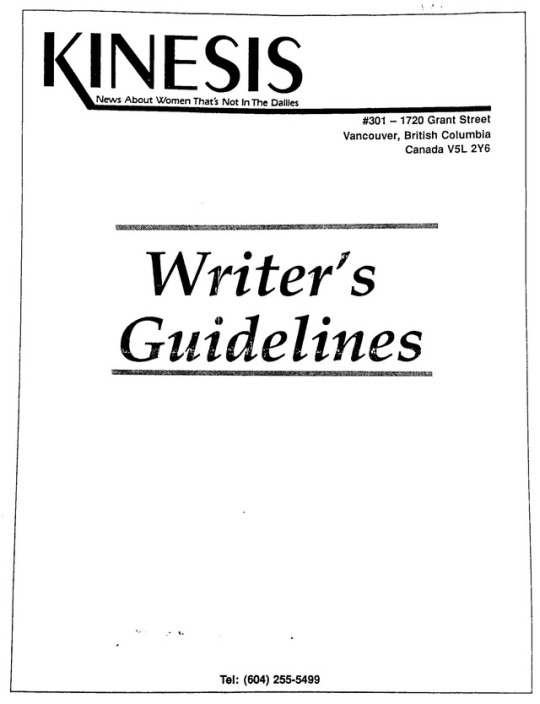
Kinesis: News About Women That’s Not In The Dailies, on language sensitivity and unbiased writing
The magazine Kinesis was published from 1974 to 2001 by the Vancouver Status of Women. It was founded during a particularly vibrant period of women’s self-publishing; periodicals and journals such as Makara, Off Our Backs, The Pedestal, The (Other) Woman, Pork Roast, The Rag and countless others became mainstays in Vancouver feminist communities, offering alternative sources for news that actively worked to disrupt media systems of oppression.
Beyond reporting on “news about women that’s not in the dailies,” they also provided female reporters with a platform to publish, and encouraged women without professional backgrounds to develop their journalism skills. In a 1985 handout titled “Kinesis Writers Guidelines” (which can now be found in the the Vancouver City Archives pamphlet collection), Kinesis outlined the process of submitting an article to be included for publication [1]. A particularly important section of that document is titled “Language and Bias Sensitivity Guide.”
Kinesis established an editorial framework which understood that writers have a responsibility to their representations of people. The english language, after all, can be considered a colonialist device, and -- like mostly anything in a patriarchal culture -- it is also overwrought with many naturalized biases [2].
The sensitivity guide details several subsections, including “Race and Culture,” “Class,” “Sexual Orientation,” “Disability,” and “Age and Appearance”. If Kinesis were still being published today, the list would likely have been updated to include more information on Indigenous Politics and Gender Identities, but the concepts present in the 1985 version are still hugely important introductions to the responsibilities of representation.
While hard copies of Kinesis can be found at both the SFU and UBC RBSC archives, the UBC Digitization Centre has made the UBC RBSC holdings available for online viewing [3]. The aforementioned “Language and Bias Sensitivity Guide” can be found transcribed in its entirety below.
LANGUAGE AND BIAS SENSITIVITY GUIDE
Introduction
Words are powerful. They can challenge stereotypes, overturn common assumptions and initiate the process of social change. They can also perpetuate sexist, racist, classist, ableist and homophobic attitudes.
Part of our work at Kinesis involves developing greater awareness of how our perspectives as writers -- even the words we choose -- are influenced by our cultural and class backgrounds. As feminist journalists, women at Kinesis have long been part of the collective process of rooting out, then changing, the sexism embedded in ordinary English usage. We no longer buy the idea that “mankind” is an inclusive term or that “girl” is a harmless way of describing a 40-year old women. [sic] In the same way, we are also in a process of discovering how language can reduce or make invisible the lives of people who don’t fit the stereotype of what is “good and normal.”
We present this guide as a work-in-progress: a brief description of some of the most common ways bias creeps into writing, along with some suggestions for change. Every woman who sits down to write is taking up a difficult, even scary, challenge. Many of us are unsure about our “voice” or are inclined to quickly self-censor. Our hope is that this guide will encourage women by triggering a new awareness about old ways of writing.
The blank page at the end of this section is for you to record any observations, questions or ideas you may have about bias in writing. Kinesis welcomes feedback and hopes that women will talk together about writing problems and solutions. Future versions of this work-in-progress will depend on your feedback.
Note: Kinesis has material on writing without bias which writers are welcome to borrow.
Race and Culture
Many words and phrases in English carry the weight of a history of racism. The words “white or light,” for example, are usually associated with goodness and purity, while “black or dark” are associated with negativity and evil. Similarly, a white lie is insignificant but a black lie is very serious. Writers can avoid reinforcing this kind of racism by choosing alternatives for words with negative, racially-related connotations. For example:
blacken…….....defame
black eye……..mark of shame
black hearted...malevolent
blackmail…......force, coerce
blacklist…..…...list of undesirables
black humour....bleak humour
Writers should take care not to assume that every issue or event affects every woman in the same way. Generalizations about women’s experience can obscure the different circumstances, priorities and analyses of specific groups of women. It would be inaccurate, for example, to write a story about reproductive rights as if choice on abortion were the most important issue. Although the white women’s movement may have focussed on abortion, for women of colour the abortion issue has been one part of a larger struggle which includes an end to sterilization abuse, population controls, birth experimentation etc.
Some of the terms used to describe colour, race and culture are so broad they convey very little. “Oriental,” for example, is a vague word that can refer to many different peoples. Writers can avoid over-generalizing by choosing more specific terms based on the country an individual comes from. The most appropriate terms are those that arise from each country or culture’s definition of itself.
Seemingly innocent words and phrases can reinforce ethnocentric viewpoints by making dominant white values and perceptions a standard. The word “minority,” for example, is frequently used to refer to people of colour, although, globally, people of colour are the majority and white people are the minority. Similarly, the phrase “visible minority” begs the question -- visible to whom? Writers can avoid the tendency to imply that white is the norm by choosing more accurate and informative phrases. Rather than “non-white,” for example, writers can use more specific terms such as Black, Native or South Asian.
Many of the terms used to distinguish between highly industrialized and less industrialized parts of the world carry subtle messages about the superiority of the industrialized world and, by implication, the superiority of white culture. These phrases include: “developing nations, underdeveloped nations, First, Second and Third world.” Consensus has not been reached about alternative terms, so writers should respect the words women choose to describe themselves.
People of colour are often presented as a burden to the rest of the world. Adjectives such as “poor, underdeveloped, backward, primitive, uncivilized, culturally deprived, and economically disadvantaged” reinforce that view. Writers can avoid feeding into this by presenting information in a positive way, making clear the initiatives people of colour have taken, the solutions they’ve found. For example, “Black people were given their freedom” suggests that Black people played a passive role in historical change. “Black people won their freedom” emphasizes the active role Black people played in their own liberation.
In general, try to be aware of the powerful and destructive influences imperialism and colonialism have had, and continue to have, on people of colour both in Canada and around the world. Although racism is a serious problem for all people of colour in Canada, writers frequently present racism as if it were something that happens only in other countries. Kinesis writers are encouraged to take the time to learn more about the past history and current struggles of people of colour in Canada.
Class
In Canada and the U.S., poverty is rarely presented in the context of class. In Canada, we hear about disadvantaged regions, or regional disparity more than we hear about the working class. As writers (and readers), most of us have been taught that Canada is a classless society. According to this message, anyone can “make it” and if they haven’t it’s because they haven’t tried hard enough, or they are lazy, or they lack the initiative to move to a better-off province or they are, at best, stupid.
This message says that poor people are responsible for their situation and that society, despite its best intentions, is helpless to aid them because they won’t help themselves. In fact, people who are poor are just as likely to be workers as on welfare. The problem is not that poor people don’t work, it’s that they don’t get paid and adequate wage for the work they do. When writing about poverty, strive to include this “big picture.”
No clear line can be drawn between class and race issues. For example, people of colour’s opportunities for education and economic security are often limited by subtle and overt forms of racism in Canada and elsewhere.
When writing on poverty issues, it is important to consider how women of colour will likely be affected -- usually more severely -- by whatever economic factor being examined. The Free Trade agreement, for example, will adversely affect women’s job security and employment prospects. For women of colour, the impact will be especially harsh since the most vulnerable sectors -- agriculture, the garment trade, the fish canning and packing industries -- employ a high percentage of women of colour.
Certain phrases play into misconceptions about the lives of poor women. For instance, “all women are poor” or “every woman is just a husband away from welfare” simply aren’t true. Women from middle and upper class backgrounds will almost always have more economic possibilities than working class women. Some phrases are patronizing, such as “the poor,” “the downtrodden;” instead, try “women who are poor” or “working class women.”
Make efforts to talk to individual women who are living in poverty. People who are poor are often presented as a faceless, nameless mass which makes identification with their struggles almost impossible. As much as possible, seek out and emphasize the political analyses of poor women, and write about the battles these women have fought and continue to fight.
Sexual Orientation
When a writer makes broad generalizations about what women want with respect to relationships, marriage, birth control, families, sexual expression, health issues etc., they are likely denying the particular concerns and experience of lesbians. At the same time, writers may fall into the trap of believing mainstream myths about lesbians: for example, that lesbians aren’t mothers, or that lesbians don’t live in families.
Whenever possible, try to be specific: instead of “Birth control is an important personal issue for women” say “Many heterosexual women see birth control as an important personal issue.”
While there is no clear consensus among lesbians and gays to a preferred descriptive word, the most popular terms are “gay people,” “lesbians,” “dykes,” “gay women and gay men.” “Lesbian woman” is considered by some to be redundant. Avoid terms “homosexual” and “sexual preference” (homosexual exists in relation to a heterosezual standark; heterosexual people aren’t described as having a seuxal preference.) Instead, use “sexual orientation.”
Disability
People with disabilities are assaulted everyday by language which limits their potential for growth and independence -- and dehumanizes them. Many commonly used metaphors are evidence of the negativity and fear with which disabilities are regarded; for example, “blind with rage,” “crippled by poverty,” “deformed by sexism” and “turn a deaf ear.”
When writing about people with disabilities, avoid patronizing cliches such as “afflicted with, deformed by, stricken by or suffering from”; instead, use a neutral term like “affected”. When “disabled” is used as an adjective, there is an implication that the whole person is disabled. Instead of “disabled worker,” for instance, say “a worker with a disability.” Whenever possible, use specific terms (e.g. a person with cerebral palsy) and avoid phrases which diminish a person’s wholeness, such as “the disabled, the handicapped or the epileptic.” The term “normal” demeans people with disabilities; use instead “able-bodied people.”
The following are ways of describing disabilities without implying a person is utterly helpless or without dignity. Rather than “needs crutches,” say “walks with crutches.” Rather than “confined or restricted to a wheelchair” say “uses a wheelchair.” Rather than “dumb” say “deaf or hearing impaired.” Rather than “mentally retarded or mentally incompetent” say “mentally disabled, or intellectually or developmentally impaired.” “Mentally unbalanced, mentally diseased, mental or insane” are appropriate only in a strictly legal sense; instead, say “mental, psychological or emotional disorder.” People who cannot speak are “mute”, not “dumb.” Rather than “stutter, stammer or lisp” say “speech impediment.” “Blind” is appropriate only for people who have no sight whatsoever; for others, use “visually impaired or having low vision.”
Age and Appearance
Women know all too well how much value the dominant culture places on age and appearance: if we’re old or not judged attractive by some males standard, then we’re considered useless.
When describing a person, avoid associating their experiences, ideas or values with their age or appearance. A belief that someone is beautiful and attractive -- or ugly and unpleasant -- is often rooted in a culturally imposed value. Generalizations about people based on their stage of life should also be avoided, such as “wild or irresponsible youth,” and “conservative older generation.” As well, stay away from cliches such as “tender age, declining years, second childhood, behind the times, prime of life, or past her prime.” [4]
Text
Intro: Alexandra Bischoff; “Language and Bias Sensitivity Guide”: Kinesis collective, reprinted courtesy of Nancy Pollak.
Notes/Sources
[1] “Kinesis Writers Guidelines.” City of Vancouver Archives, pamphlet collection fonds; reference code: AM1519-: PAM 1990-83.
[2] Team, The ITunes U. "Postcolonial English." OpenLearn. The Open University, 06 July 2011. Web. 04 Dec. 2016.
[3] Esquin. "Kinesis Is Now Available Online!" Digitization Centre. University of British Columbia, 21 Oct. 2013. Web. 03 Dec. 2016.
[4] “Kinesis Writers Guidelines” located at the City of Vancouver Archives, pamphlet collection fonds; AM1519-: PAM 1990-83.
Image
Courtesy of Nancy Pollak. Kinesis Writer’s Guidelines (Est June, 1985). Located at the City of Vancouver Archives, pamphlet collection fonds; AM1519-: PAM 1990-83.
#kinesis#feminism#feminist collective#feminist writing#vancouver activism#vancouver feminism#vancouver archives#art and archives#women in publishing
0 notes
Photo
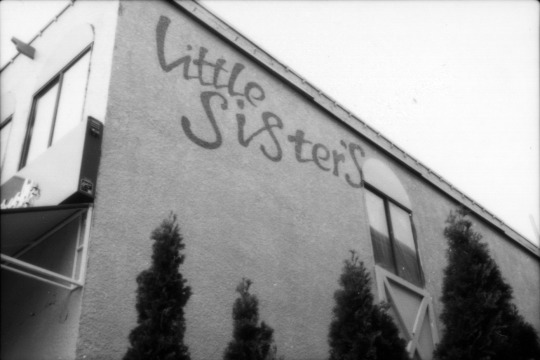
Little Sister’s Book Seizures: Censorship and Erasure in Government Legal Systems
Text by Micaela Kwiatkowski
Little Sister’s Book & Art Emporium is an integral part of the queer community in Vancouver. In 1983, Bruce Smyth and Jim Deva founded Little Sister’s as a sex positive community bookstore that provides queer resources, literature, and adult toys. Among these resources, Little Sister’s imports international gay and lesbian texts, magazines, and catalogues from Europe and the United States. Three years after opening, Canadian Customs began seizing queer materials being imported to Little Sister’s; customs obtained these items under the censorship laws within the Canadian Customs Act and Customs Tariff. Under these two laws individual Canadian Customs officers possess the subjective power to obtain any material they deem as obscene. As a result of the initial seizures, a two decade legal battle began between Little Sister’s and Canadian Customs. Throughout the course of the battle the bookstore argued that the seizures were targeted under systemic issues of marginalization and prejudice towards the queer community. In constructing their argument Little Sister’s and the queer community asked themselves:
How do we challenge Canada Customs’ decisions and...prove that the problem goes deeper than specific book seizures and lies rooted in a system that considers gay and lesbian material obscene? [1]
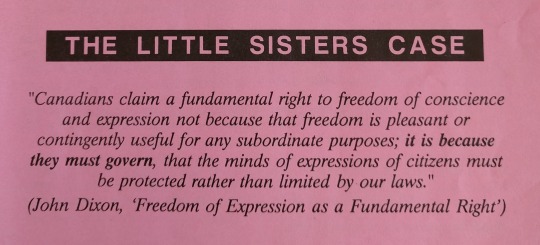
In a series of articles in support of Little Sister’s, activists and scholars developed a discourse that exposed instances of discrimination towards the queer community in Vancouver. One of these was a journal article that documented an anthropologists’ testimony to the court where he had to defend the ‘naturalness’ of queer relationships from an anthropological perspective in order to discredit Canadian Customs actions. This was followed by a multitude of articles documenting reactions to the censorship battle, evidence of discriminatory and targeted seizures, as well as public support from lesbian activist and writer, Pat Califia [2]. Little Sister’s Manager, Janine Fuller, highlighted the impact of systemic prejudice towards the queer community in an article, exclaiming that “a lot of stores are afraid to import gay and lesbian material, so it becomes self-censorship” [3]. Fuller established that Little Sister’s had become an activist in the community by providing resources that are often censored from from the public. These instances of self-censorship demonstrate the significance of the Little Sister’s legal battle in establishing a discourse that exposed multiple layers of public and private censorship in Canada.
In 2000, after a series of articles, community support, and legal battles against Canadian Customs, the Supreme Court of Canada justified Canadian Customs actions towards Little Sister’s. Although the court justified the acts of Canadian customs, they partially resolved the issue by acknowledging that the seizures had been targeted and that Little Sister’s had been subject to discrimination. Going through the Little Sister’s book seizures archive at Simon Fraser University, the articles highlight the power of the collective voice as an agent to expose issues of discrimination and marginalization that continue within government legal systems. Contemporary artists have contributed to the discourse around censorship and borders through investigations into customs and immigration. This includes German artist Maria Eichhorn’s exhibition at the Morris and Helen Belkin Gallery last year. In the exhibition, Eichhorn documented actions of erasure and censorship against Mapplethorpe’s queer photography book, Mapplethorpe: Die Grobe Werkmonographie. Eichhorn’s process included sending copies of the book through Japanese customs and immigration in order to see how their importation laws would materialize. Instead of seizing the material, Japanese customs used erasers to eliminate the genitalia from the photographs, leaving a cloud-like aura on the images. Through the erasure of queer and pornographic images in Eichhorn’s exhibition, Eichhorn materializes traces of self-censorship, international censorship laws and discrimination, all of which contribute to the political discourses surrounding the Little Sister’s book seizures.
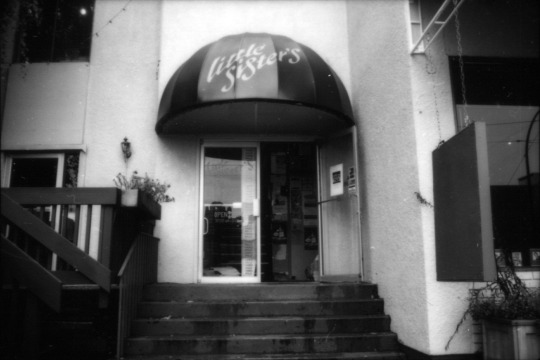
Notes/Sources
[1] “Xtra West Article/Winter 2006.” SFU Archives; Press Gang Publishers fonds; reference code: F-184-7-0-0-3: Censorship. [2] “Little Sister’s Archive.” SFU Archives; Press Gang Publishers fonds; reference code: F-184-7-0-0-3: Censorship. [3] “Janine Fuller on Censorship” SFU Archives; Press Gang Publishers fonds; reference code: F-184-7-0-0-3: Censorship.
Images
Courtesy of BC Gay & Lesbian Archives. “LS Thurlow 1980s FrontageA,” circa 1983. Angeles newspaper fonds.
John Dixon. “THE LITTLE SISTERS CASE,” circa 1993. Simon Fraser University archives, Press Gang Publishers fonds; F-184-7-0-0-3 Censorship. Attempts are being made to contact the copyright holder; if the image belongs to you and you would like us to remove it, visit the Contact section of our Tumblr to find our email and Take Down Policy.
Courtesy of BC Gay & Lesbian Archives. “LS Thurlow 1980s Side3,″ circa 1983. Angeles newspaper fonds.
#little sister's book & art emporium#book seizures#censorship#BC Gay & Lesbian Archives#vancouver activism#little sister's v. canada#lgbtq activism#queer activism
1 note
·
View note
Photo
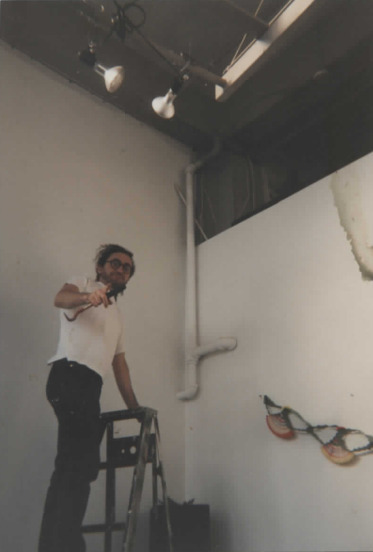
An Interview with the Living Archive: Glenn Alteen and grunt gallery
Text by Fiorela Argueta
As a participant of the myriad of discussions partaken on June 13th, 2016 for the Morris and Helen Belkin Art Gallery event Reactivating: Art and Archives, I was able to engage in discussions concerning art, activism, and archives. One of these conversations in particular, invited me to bring forth my experiences with grunt gallery’s archives. My exploration with grunt’s archive has allowed me to challenge the presupposed objectivity of archives, when they should also be regarded as personal spaces. To clarify, the archives are public spaces in their accessibility to those who seek them (physically or digitally), yet it is easily forgotten that they are also about a person who has laboured both consciously and unconsciously on the archive. Such is the case with Glenn Alteen.
My interest with Glenn in relation to grunt’s archival history surfaced when I began to find his documented presence in the archives themselves. At one point while assisting grunt gallery to digitize their archives, I was looking at photo negatives and came across an image of a young man. After a moment, I realized the person I was staring at was a young Glenn with an afro.
After this initial experience, more historical traces of Glenn were to be found in the archive, they manifested themselves as film negatives or personal letters addressed to Glenn and by Glenn between artists and exhibition collaborators. Through this period at grunt that I realized that archives, despite being seen as objective historical records, are very much a space for personal memories. For instance, I may find a document that does not seem to fit its placement in the archival binder, and I can simply ask Glenn if he remembers how this document came about so I may find a more suitable category. He usually remembers.
Due to this ability, my friend Dan Pon, who is also the Archives Manager at grunt gallery, jokingly comments to me that he regards Glenn as a “Living Archive.” And so, I decided to have a conversation with Glenn and discuss his presence embedded in the production of the archives.
FIORELA: When grunt gallery was established, did you have intentions of archiving the artists and their shows?
GLENN: Yes, from the beginning we decided we wanted an archive, but we had no idea how it would be used.
FIORELA: Was your motivation to begin archiving a means to professionalize the artist-run centre?
GLENN: Not really, for us it sort of just happened... A lot of photographs from performances you see were taken by Merle Addison -- you have probably seen them. We also realized that we were paying for these photographs to be taken but no one was seeing them! It was really not until the mid 90s that we began organizing them into binders.
FIORELA: When you view the archives do you see your life in them?
GLENN: In some ways, yes. Archives talk different things to different people. What I remember is not always in the archive: dialogues I had with artists are not often reflected. Although, every now and then, there are “snippets” of these conversations that were able to be recorded into the archives. Those letters you have read that were sent back and forth with myself and the artists are examples of these “snippets.”
FIORELA: Whenever Dan and I discuss the history of the archive, he often refers to you as a “living archive.” What do you think of this title?
GLENN: Hah! I do know for certain Dan likes to call me that! Like I said before, archives recall different things to different people -- there are histories around the archive. Myself and Merle have our own memories about certain events in the archive, and so our relationship with it is different. I do not deny my presence in the archive, and a lot of people look at me as the continuity factor, but I was not alone. grunt values long-term investment and there has been a lot of people who have been active for many years as well. You just don’t see this history on the archive.
FIORELA: Do you see yourself as a “living archive”?
GLENN: Do I consider myself a “living archive”? No, I am not precise enough to be a living archive. Memory is selective.
FIORELA: I hope this does not sound morbid, but what do you think the archives will be like once you are no longer actively involved at grunt?
GLENN: I think the archive post-Glenn will be bigger! There will be more interest in the archive as a result. Now that we have people, like yourself, digitizing our physical material, there is a wider viewership for it. In a sense, its second life is much wider than its first life… The second life is what the younger generation will see. The shows and the exhibitions will now have a different conversation than when they first occurred and were talked about. There will be clashes of meaning, for example: something that happened 20 years ago will now have more relevance now than before during its time. It’s exciting! [1]
Glenn’s final answer makes me curious about the boundaries of archives as public space and personal space merge, specially now in the digital realm. Glenn suggests the younger generation will be accessing the archives through its second life in the electronic domain. What are we then supposed to make of from our digital trace? We are all in charge of archiving our lives in digital platforms, whether it is done through Facebook timelines, tumblr blogs, or even our computer files, such as photos and documents, etc. These websites, or classification systems, are now replacing previous modes of archives and function simultaneously as public and private. This new dimension in regards to archives demands research and contestation, but looking back at the personal relationships formed in the documentation of physical archives, such as Glenn with grunt gallery, provides us a framework for us to be self-reflexive with our new ‘second life’ in the digital scheme.
How do you imagine someone else looking up your archive?
Fiorela and Both/And would like to thank Glenn Alteen and Dan Pon for their kind assistance.

Sources/Notes
[1] Alteen, Glenn. "An Interview with the Living Archive." Personal interview. 1 October. 2016.
Images
Courtesy of grunt gallery. Glenn Alteen installing at grunt gallery, n.d. grunt gallery’s Activating the Archive and Activation Map.
Courtesy of grunt gallery. Glenn Alteen’s birthday, 1989. grunt gallery’s Activating the Archive and Activation Map.
#grunt gallery#Vancouver artist run centres#Vancouver arts#Glenn Alteen#living archives#Vancouver archives#interviews
0 notes
Photo
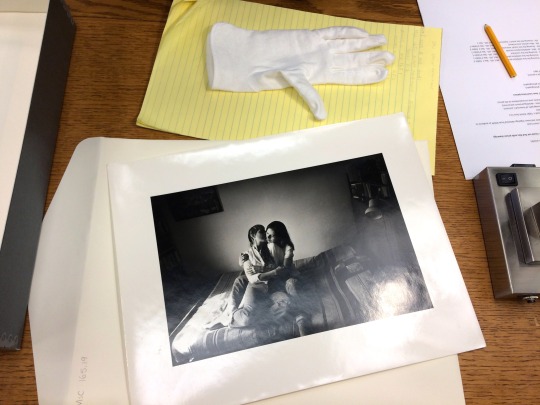
Kiss & Tell (or kiss & listen)
Sitting warm and dry inside dust-controlled archives and sheltered from Vancouver’s winter rain, I sit and sweep through image after image of lesbian love and swoon over three artists’ labours. Persimmon Blackridge, Susan Stewart (photographer), and Lizard Jones are the Kiss & Tell Collective, and before their photographs were encased in archival envelopes as they are now, they were printed and hung for all to see in their interactive exhibition Drawing the Line (1988-1992).
I write brief notes as my research partner Anna and I suss out the archive’s holdings, waxing poetic because that is what the images seem to require:
Two women kiss passionately in a cascading brook. I think of Fragonard with his frothy, sensual trees.
Next, kissing in front of a raging waterfall, shirt soaked. Close-up composition of one woman holding her partner’s chest, water cascading behind.
The front cover of harlequin novels.
Is the waterfall cliche? Perhaps only in concept; after all who actually goes to waterfalls to kiss?
Romance begets cliche, and intimacy does not spoil through repetition.
A few envelopes later: nearly a stock photo, two, broadly smiling women, coupled in mirth.
Almost nearly a stock photo, except for the hairy armpit.
While laughing, one woman sprays the other’s hairy armpit with a shower-head.
Kissing in the bathtub with their clothes on.
Kissing breasts, close-up of biting nipple, on the bed, holding close.
Tearing shirt to reveal bird tattoos on breasts and raucous laughter in blurred moments of ecstasy.
“I can’t quite tell what’s going on there…” as we peer into the next sleeve, parted by gloved hands. “It’s a woman…” says Anna, looking again, unable to qualify much further. And “…a tattoo gun.”
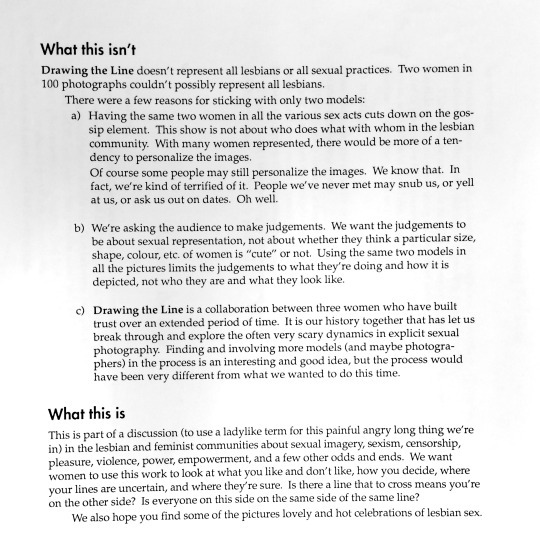
Drawing the Line travelled between 1988-1992. Just imagine: erotic images traversing galleries with accompanying instructions for participation. Three friends (never lovers, except through art and image) invite you to write your responses on the wall. What do the images make you think about and where do you draw your personal line? A call for women anyways… men were given their own private space to reflect, in a coil bound book where handwritten messages stretched pages in length and tugged at the edges of female proclamations.
And the images can become sinister—depending on how comfortable the viewer is with bondage—with whips and ropes and cuffs and male voyeurs, et al., these women play the gamut of sexual fantasy for viewers to capitulate to.
One woman writes on the wall: “To me this looks like the sexist 50’s bullshit (strong dominant male in leather, weak submissive female in silk) that we’ve been fighting externally & internally for years. Why eroticize it?” [1]
To which another replies: “Some people like the feel of leather while others prefer silk—does this make either of them masculine or feminine?” [2]
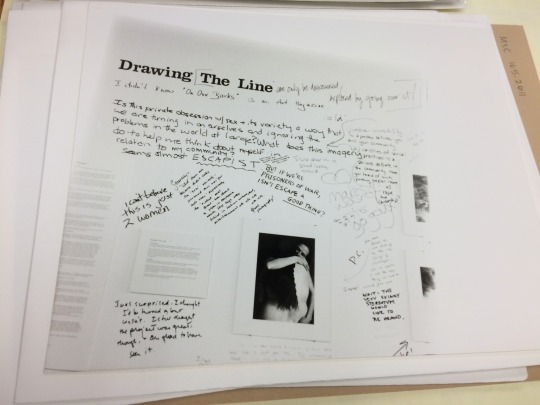
Below the exhibition vinyl of one documented installation, someone pens in thick black ink: “Is this private obsession w/sex + its variety a way that we are turning in on ourselves and ignoring the problems in the world at large? What does this image do to help me think about myself in relation to my community? Seems almost ESCAPIST.” [3]
And beside: “BUT IF WE’RE PRISONERS OF WAR, ISN’T ESCAPE A GOOD THING?” [4]
The images are solitary, private—rough and sweet in their seclusion—and even more so now that they’re tucked away in the archive for safekeeping. But they are also, of course, an act of protest: 100 photos of lesbian love, in as many manners as the artists can conceive, for the sole purpose of reminding the viewer of their voyeur, their preferences as public. The imbibed power of dialogue, of espoused discussion—to breed voice above murmur—these photos do more than kiss and tell. It was not enough to tell; the collective also listened.
Text
Alexandra Bischoff
Sources/Notes
[1] MSC 165.2601, circa 1989-1992. Simon Fraser University Bennett Library Special Collections & Rare Books, Kiss & Tell fond: MSC 165-0-1-1-0-6, Drawing the line exhibition photos. Courtesy of Susan Stewart.
[2] Ibid.
[3] MSC 165.2603, circa 1989-1992. Simon Fraser University Bennett Library Special Collections & Rare Books, Kiss & Tell fond: MSC 165-0-1-1-0-6, Drawing the line exhibition photos. Courtesy of Susan Stewart.
[4] Ibid.
Images
Courtesy of Susan Stewart. Kiss & Tell Collective, image from exhibition: archival description number MSC 165.19, circa 1988-1992. Simon Fraser University Bennett Library Special Collections & Rare Books, Kiss & Tell fond: MSC 165-0-1-1-0-1, Drawing the line exhibition prints.
Courtesy of Susan Stewart. Kiss & Tell Collective, “What this isn’t” partial artist statement, circa 1988. Simon Fraser University Bennett Library Special Collections & Rare Books, Kiss & Tell fond: MSC 165-0-1-2-0-3, MIscellaneous exhibition and press materials.
Courtesy of Susan Stewart. Kiss & Tell Collective, exhibition installation documentation: archival description number MSC 165.2603, circa 1988-1992. Simon Fraser University Bennett Library Special Collections & Rare Books, Kiss & Tell fond: MSC 165-0-1-1-0-6, Drawing the line exhibition photos.
#kiss & tell#kiss & tell Vancouver#Vancouver activism#art and activism#Vancouver arts#Vancouver archives#archives#LGTBQ#queer activism#queer aesthetics#lesbian art#lesbian activism#creative protest#performativity
3 notes
·
View notes
Photo
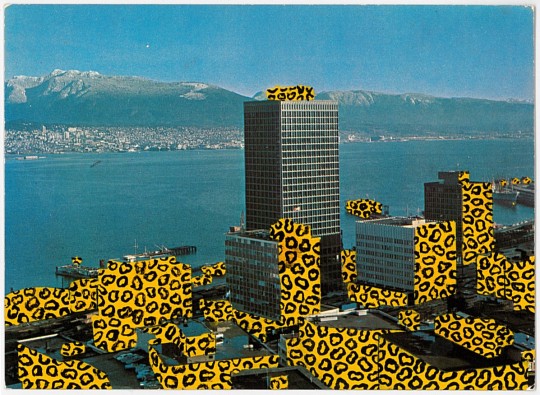
Musing over Metro Media and Mail Art: Nostalgia for (big) small networks
In September 2014, I had upwards of 1700 unread email messages in my inbox. The majority of those unread emails came from organizations for which I had at one time completed a survey, signed a guest book, used a service, or thought (albeit very briefly) that “it would be nice to hear what special offers they’ll have in the future.” Besides solicitors, many unread messages were actually from myself: a file, URL, or note that I had sent, addressed to “Me,” and then promptly forgotten about. Two or three were from my mother, and when I uncovered these from within the 1700 email mound, I felt severely guilty of my passivity.
In October 2014, I found myself elbow deep in a fragrant box of typewritten correspondence from the 1970s and 80s. Unlike my inbox, these letters had all been read carefully, and responded to with feeling. Lenore Coutts didn’t necessarily organize her files with detail precision, but she also didn’t keep her correspondences for nothing. They collectively formed a hazy picture of the 1971-1984 Vancouver organization Metro Media, which she directed in its final years. Without these flurried papers, we might not know the full extent of Metro Media’s impressive impact on Vancouver’s artist run centres. I also may not have become so compelled by the history of correspondence in general—or for that matter, how the postal service informed the internationally influential movement of Mail Art.
Mail Art was originally used—like much conceptual art of its time—to circumvent the gallery structure. Rebellious in their nature, many artists of the 1960s and 70s wished to undermine the hierarchies of commercial and museum art practices. Akin to landscape artists’ site specificity, by creating artworks that were enlivened only through the process of mailing and receiving, mail artists worked against typical exhibition formulas.
Beyond eschewing existing institutional structures however, there was a secondary function that Mail Art fulfilled. This was to connect with other artists via meaningful correspondence. Emily Robertson suggests that Mail Art “provided artists with a feeling of independence and self-sufficiency by replacing the gallery, as a means of validation, with a large network of other artists” [1]. Unlike trying to find exhibition opportunities, getting involved with this form of networking was simple. Specifically, all one would have to do to be included was to get their hands on a recipient list, become included on one, and send out multiples of their own postal creations.
Joining the network became easier once Mail Art extended past New York City in the early 1970s. Mail Art was actually quite exclusive in its earlier iterations; this would have been due to a more correspondence heavy intention, or what Ken Friedman explains was a “reciprocal or interactive communication” through Mail Art, as opposed to a kind of “one way communication, mailed out without any requirement for response” [2]. Ray Johnson is the figure who heavily instigated Mail Art in NYC; he also started the New York City Corespondance School in 1962 (sic) [3]. Johnson’s postcards were original collages, often inspired by the recipient in some manner in order to strike up a dialogue. By the end of his life, Johnson had acquired such an impressive and coveted list of artists’ addresses as to become “the envy of many colleagues” [4].
The listing of mail artist addresses opened quite quickly through the use of magazine publications. Toronto’s artist group General Idea created FILE magazine “as a way to archive—or file—[the] deluge of mail art” that was surging slowly across North America [5]. As well as printing Mail Art from their regular contributors, FILE also published recipient address lists and image request lists: these were the readers’ open invitation to get involved with the network.
It was fitting to use a medium as democratic as the postal service to create self-supporting artist networks. Considering the era’s technological contexts—before the privileges of fax machines, cell phones and the Internet—the post office was a means of relatively cheap communication that all citizens were already given access to.
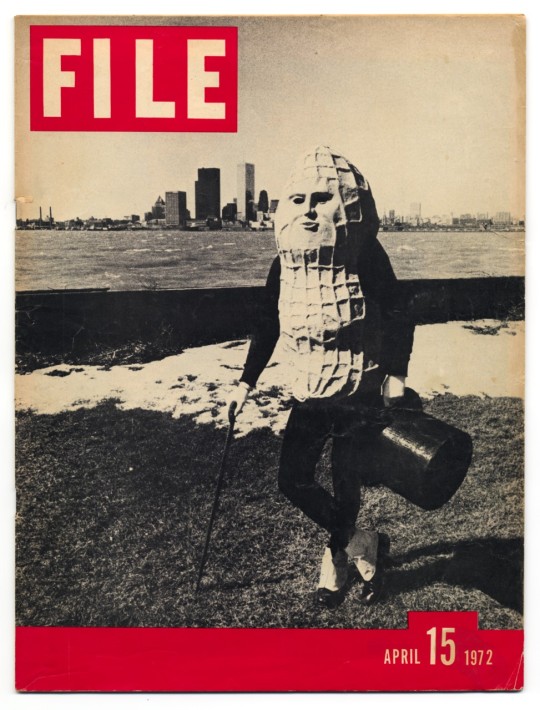
Along with her own typewritten correspondences, Lenore Coutts kept binders and boxes full of Mail Art. These at first seemed slightly out of place in the archive, considering that Metro Media primarily dealt with video and sound. However, it is in the organization’s 1971 mandate to promote “community involvement in producing programs and publications” [6]. In this context, it should not come as a surprise to discover Metro Media opened itself to monthly Mail Art exhibitions in its latter years, and provided Vancouver artists with cheap access to their color Xerox machine beginning in 1982.
Xerox machines became an important tool of Mail Artists. Much of what makes up Coutts’ Mail Art binders were Xeroxes, which Metro Media’s monthly Mail Art exhibition organizer GX Jupitter Larsen says was integral to in order to save costs. “You don’t see that much of it in contemporary Mail Art,” he muses, “but back then I guess people had to save as much money for postage as possible . . . it was the most economic medium to take advantage of in order to make multiple copies” [7]. As Mail Art networks expanded exponentially through the 1970s, more and more copies would become necessary.
According to mail artist Guy Bleus, there is a subcategory of Mail Art called Copy Art. In his definition, copy art is:
art without an original. An important part of it is xerography or Xerox mail art. Copy art is an instant art form and provides a quick method to get multiples . . . [and also creates] the potential of copy art cards, enlargements, reductions, degenerations, body art, [and] copy motions. [8]
I have two very particular reactions to the idea of Copy Mail Art. The first is a flutter of nostalgia for pre-Photoshop, photographic manipulations. The second is the realization that Copy Mail Art had the potential to reach many people all at once, providing an intimate experience unusual within the realm of mass production.
While absent-mindedly scrolling through my Facebook Newsfeed last week, I came across a flagrant gem—one that humorously reminded me of my inbox full of solicitors. David Mazières and Eddie Kohler published a faux-scholarly article called “Get me off Your Fucking Mailing List,” which contained only those seven words for ten full pages. This was Mazières and Kohler’s response to so-called predatory publishers, or open-access online journals that troll university inboxes. These scam publications “pose as legitimate journals so researchers will pay their processing fees” [9]. Besides being told that their article was “excellent,” the two were prompted to pay the International Journal of Advanced Computer Technology $150 for publishing their work [10]. In this instance, not only did Mazières and Kohler prove that these journals don’t peer review, they also proved that they don’t even open their respondents’ attachments.

This kind of correspondence is comical, but only because it exposes the passivity typical of our online interactions. Now, while our online networks expand beyond cognitive reach, Mail Art might re-find its political roots in satirical spam-art. “It’s steady work, with few pauses” writes Graham Parker in a short text called Spam Filtering [11]. This process, he continues, is “[a] repetitive and thankless task just on the side of unthinking” [12]. And perhaps it is just as unthinking as the spam itself, which is exemplified the rest of Parker’s artists’ book Fair Use (Notes from Spam), where the artist uses his own Junk folder as fodder for a nonsensical narrative. The texts ring familiarly in our spam-filter memories:
… fast growing (up to 1cm per day), matures early (at 40-60 days old) and produces millions of spores. Do you want opt0ut? Stmoachaches … This email was sent to you by your friend from our software stock shop. Your friend’s message: Yesterday I found great software stock eshop while I was looking for Really cheap prices and great offers everyday . Fellow, look here, isn't it a great offer? … I got your contact through my personal search on the internet. I am contacting you due to the present situation as regards to a special panel set up by the present democratic administration … (sic) [13]
The democratic fashion from which Mail Art was borne eventually meant that any control or persuasion of the movement was usurped from its original creators. In the eyes of some, this was a negative development. Robertson deliberates that “FILE had opened Pandora’s box, letting the world’s artistic misfits believe that a stamp could replace actual talent” [14]. Sloughs of generic worldwide correspondence didn’t slow down the movement, but certainly signaled a change in its attitude. An original contributor Robert Cumming, for example, demanded that mail artists new to the genre “stop violating [his] mail slot each morning,” and that he could “no longer answer a bad piece of mail” [15]. For Cumming and many others, Mail Art had become nothing more than glorified junk mail. FILE magazine’s last issue with Mail Art content was in 1975.
The network outgrew some of its original publications, but alternative ones took their place. Exhibitions occurred worldwide and the network kept expanding. It became an almost necessary facet of Mail Art participation to save what was received. Larger publications would have felt this responsibility most heavily, with submissions stacking up daily. FILE’s creators, for example, opened up Art Metropole in order to preserve the Mail Art that they were continually being sent. Acquisitions ceased in 1996, and the archive’s permanent 13,000 item collection was donated to the National Gallery of Canada in 1999 [16]. Here, visitors are welcomed to interact with the collection. All original envelopes have been removed, but a white box encases each item, allowing for the same exciting sensation of opening a piece of mail for the first time [17].
The only letters I have received in my physical mailbox over the past three months have been about government cheques or government debts, and a birthday card from my mother. I do however, correspond daily through email; attached to me at my waist, my iPhone does not hesitate to notify me once I have received another piece of electronic correspondence. When I look through Lenore Coutts’ yellowed letters and handwritten notes, I wonder at the pace of things before our online networks. Despite the urgency lacked from high-speed Wi-Fi, I get the sense that Coutts’ communications must have felt far more direct.
Mail Art was the symptom of artists’ desiring intimate and international contact with one another, outside of imposed gallery hierarchies. They used it to genuinely reach out in ways that online social networking only attempts to achieve. Of course I do not blame Mail Art for the junk mail phenomenon, which must have begun shortly after postal communication became available. But it is exemplary of any network which expands to such an overwhelming degree that multitudinous correspondence will inevitably slip into the unwelcomed status of spam. Mail Art has become glorified—often shown in the institutions it once eschewed—and I wonder if it could ever have been kept free from the clutches of social overindulgence. It only proves the same of our current forms of communication; now that our networks are opened wide, we must struggle to pull them shut with email filters and customizable privacy settings. Indeed, privacy has become the ultimate showdown: a holding-back between ourselves and the potential suffocation of the wide world web.
Text
Alexandra Bischoff
Notes/Sources
[1] Robertson, Emily. Pushing the Envelope: The Evolution of Mail Art in Canada. Thesis. Montreal, QC. Concordia University, 2007. p 31. Apr. 2007. JSTOR. Web. 3 Nov. 2014.
[2] Welch, Chuck. Eternal Network: A Mail Art Anthology. Calgary: U of Calgary, 1995. p 3. Print.
[3] Ed Plunkett originally named the school, which Johnson adopted with the intentional misspelling. Found in: Robertson, Emily. Pushing the Envelope: The Evolution of Mail Art in Canada. Thesis. Montreal, QC. Concordia University, 2007. p 9. Apr. 2007. JSTOR. Web. 3 Nov. 2014.
[4] Ibid. p 20
[5] Bright, Betty. "The Magazine as Mirror." No Longer Innocent: Book Art in America, 1960-1980. New York City: Granary, 2005. p 152. HUMN-311-F005 2014 Moodle. Web. 11 Sept. 2014.
[6] Cook, Robert. Proposal for a Provincially Funded Community Media Resources Centre. Proposal. Comp. Bill Bargeman, Penny Joy, Dennis Ribideau, Sheila Roswell, and Sheila Smythe. Vancouver: Metro Media, 1971. p 41. Print.
[7] Larsen, GX Jupitter. Metro Media Mail Art. GX Jupitter Larsen. Rec. 23 Nov. 2014. WAV.
[8] Bleus, Guy. "Mail-Art Initiation." MAIL-ART INITIATION. Web. 22 Nov. 2014.
[9] Stromberg, Joseph. ""Get Me Off Your Fucking Mailing List" Is an Actual Science Paper Accepted by a Journal." Vox. 21 Nov. 2014. Web. 22 Nov. 2014.
[10] Ibid.
[11] Parker, Graham. Fair Use: Notes from Spam. London: Book Works, 2009. Print.
[12] Ibid.
[13] Ibid.
[14] Robertson, Emily. Pushing the Envelope: The Evolution of Mail Art in Canada. Thesis. Montreal, QC. Concordia University, 2007. p 37. Apr. 2007. JSTOR. Web. 3 Nov. 2014.
[15] Ibid. p 38
[16] Ibid. p 47
[17] Ibid. p 48
Images
Eric Metcalfe, Leopard Realty Postcard, 1971-72. Collection of the Morris and Helen Belkin Art Gallery, gift of the artist, 1997.
General Idea, FILE Magazine, Vol. 1, No. 1, April 1972. Collection of the Morris/Trasov Archive, Morris and Helen Belkin Art Gallery. Courtesy of the Estate of General Idea; Photo: Michael R. Barrick.
Eddie Kohler and David Mazières. “Get Me Off Your Fucking Mailing List Figure 2,” 2014. Courtesy of Eddie Kohler.
1 note
·
View note
Photo
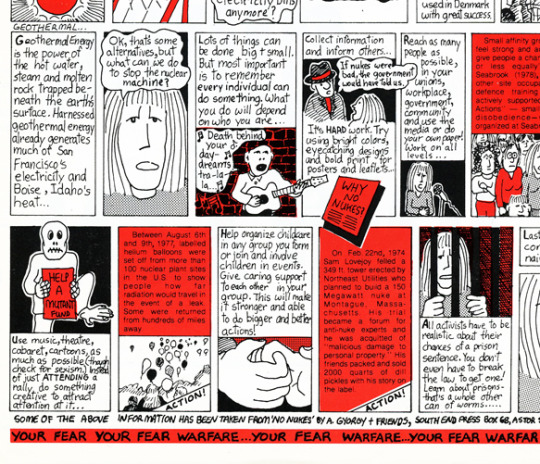
Activism 101: RUMBLES! instructs
Perhaps you have never demonstrated before, have never stood in a picket line, or petitioned in public for progressive change, but in the wake of the public resurgence of regressive politics, participation in activist activities could become far more commonplace. In their 1981 anti-nuke comic “RUMBLES!,” David Lester and Brooke Lyndbrooke set-up some excellent standards to follow for first-time activists. The following text was found in the above excerpt:
“Ok, that’s some alternatives, but what can we do to stop the nuclear machine?”
Lots of things can be done big + small. But most important is to remember every individual can do something. What you do will depend on who you are… Collect information and inform others…
. . .
Reach as many people as possible, in your unions, workplace, government, community and use the media or do your own paperwork on all levels… Use music, theatre, cabaret, cartoons, as much as possible (though check for sexism). Instead of just ATTENDING a rally, do something creative to attract attention at it…
Between August 6th and 9th, 1977, labelled helium balloons were set off from more than 100 nuclear plant sites in the US to show people how far radiation would travel in the event of a leak. Some were returned from hundreds of miles away.
Help organize childcare in any group you form or join and involve children in events. Give caring support to each other in your group. This will make it stronger and able to do bigger and better actions!
On Feb 22nd, 1974, Sam Lovejoy felled a 349 ft tower erected by Northeast Utilities who planned to build a 150 Megawatt nuke at Montague, Massachusetts. His trial became a forum for anti-nuke experts and he was acquitted of “malicious damage to personal property.” His friends packed and sold 2000 quarts of dill pickles with his story on the label.
All activists have to be realistic about their chances of a prison sentence. You don’t even have to break the law to get one! Learn about prisons - that’s a whole other can of worms…...
Text
Alexandra Bischoff (Introduction)
David Lester and brooke Lyndbrooke (aka Marian Lyndbrooke)
Image
Lester, David, and Marian Lyndbrooke. "RUMBLES!" RUMBLES! Reality Asylum 1981: 3. Print. Simon Fraser University archive, Women’s Bookstore fonds: F-111-7-1-28 Event Posters / Press Releases 1/2 (1970-1982). Courtesy of David Lester and brooke Lyndbrooke.
#Vancouver activism#art and activism#how to demonstrate#rally together#RUMBLES!#anti-nuclear protest#protest#creative protest#demonstration
1 note
·
View note
Photo
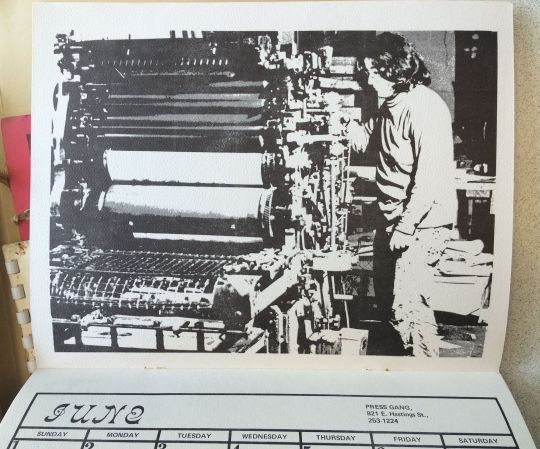
Press Gang’s Solna
Pictured for the month of June in a 1975 calendar, Sarah Davidson stands beside Press Gang Printer’s Solna press. When asked about the photograph, Davidson recalls:
The press in the photo was the Solna which could print 18x24 paper - including newsprint. We printed various newspapers and books on it. She Named It Canada was printed on it. Makara was printed on it (sometimes with difficulty). I think we printed the Pedestal, and I remember a very late night printing a special edition of the Peak. Women Look at Psychiatry, too.
Text
Alexandra Bischoff, Sarah Davidson
Image
Press Gang Printers, “JUNE,” 1975. Located in the Simon Fraser University Access to Memory archives, Vancouver Women’s Bookstore Fond: F-111-7-1-19 Calendars (1973-1976). Courtesy of Sarah Davidson and Press Gang.
#press gang#press gang vancouver#vancouver feminism#vancouver in the 70s#feminist publishing#Makara magazine#the Pedestal#women in print#women in publishing
0 notes
Photo
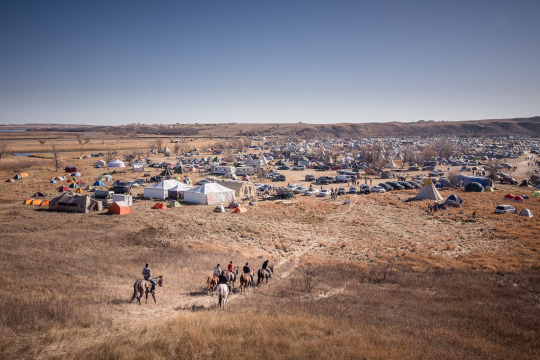
New activism, old problem: Standing Rock and Muckamuck Restaurant
Indigenous peoples have consistently been made to protest for their rights in North America and abroad. Whether standing in solidarity with our Sioux neighbours at Standing Rock, or considering more localized issues as the Muckamuck Restaurant picket strike on Davie Street (which lasted from 1978-1982), it does not take an exhaustive search to find examples of colonial exploitation of Indigenous relationships. Looking at these two, very different instances of protest, we can begin to see how certain activist strategies have begun to shift online, what working from both inside and outside of established systems can look like, and how time, above all else, can be the Achilles heel of activism.
Standing Rock
If you have a Facebook account, then it’s likely that you or someone you know has virtually visited North Dakota since the start of November. According to BBC, more than 1.4 million people “checked-in” at the Standing Rock reservation between October 29-November 2, 2016, maintaining that while they might not physically be able to join the Water Protectors in the No DAPL protest, they can at least show their solidarity online [1].
When people were first urged to “check-in,” it was in an effort to confuse law enforcement agencies. The fear was that protesters would be identified through the online platforms’ geolocation technologies, making them more vulnerable to persecution [2]. While this original purpose has since been proven inconsequential by sources such as Snopes (the police denied that they had been using Facebook check-in’s to monitor protesters), the show of solidarity accomplished much more than its attempted ruse [3].
Since the advent of the internet, it has become easier to learn about issues and mobilize protesters. And although critics of online activism warn against “slactivism” and “clicktivism”—two forms of lazy politics that do not go beyond a facebook “like” or “share”—the power of online awareness should not be underestimated [4]. It is true that purveyors of social change cannot expect that difference can be made by simply “signing” an online petition; there needs to be equal parts action and discussion in effective social reform. However, platforms such as Facebook and Twitter can still be powerful activist tools.
Acts of civil disobedience, fundraising, and parallel gestures of protest are organized through social media. Inspired by the “No DAPL” protest at Standing Rock, a recent movement has seen Americans openly criticizing or closing their accounts at banks that finance corporate interests like those of big oil [5]. Bracketed by the hashtag #bankexit, the movement attempts to pull support out from under the DAPL project, while protesters on the frontlines push back pipeline construction crews [6].
Though online activist tactics are new, the problems that the Sioux are facing are unfortunately as old as first contact. It is important to realise: we are not just standing in solidarity over the protection of water, or against oil companies’ lack of environmental consciousness. This is a protest for Indigenous rights. It is an insistence for decolonial politics, and for the amplification of Indigenous voice. “No DAPL” makes visible the double standard of colonizers’ relationship with First Nations peoples; colonial governments may offer empty, regulatory recognitions to Indigenous groups, but will quickly rescind treaty rights when disavowal better suits corporate goals [7].
Working through American bureaucratic systems is never simple, but these processes can become conveniently opaque when minoritized groups are “stirring trouble” (read: protecting their rights). The Sioux at Standing Rock have been standing up against DAPL since August of 2016, though the US Army Corps of Engineers’ convoluted and one sided environmental assessment process began much earlier, in February of 2015 [8]. When these often drawn-out systems fail, disenfranchised groups such as the Standing Rock Sioux must then turn to out-of-system protective measures.
The peaceful acts of civil disobedience by “No DAPL” have seen violent police retaliation [9]. And with many charities beginning to collect donations for a “Standing Rock Winter Fund,” [10] it doesn’t seem like there is an end in sight for the conflict—despite President Obama’s promise to discuss alternative routes for the pipeline [11]. Now that President-elect Donald Trump has appointed climate change denier Myron Ebell to lead his Environmental Protection Agency transition team, an expedited outcome of the protest is looking far less possible [12].
With odds stacking against the Water Protectors, allies need to stay focused on the cause. Time is the enemy of protest, especially for those who are using online platforms as their medium. After the election, for example, news of America’s President-elect began to overwhelm No DAPL updates. As more time passes and fewer news outlets cover the crisis, some of those who “checked-in” at Standing Rock may forget that they were at one point invested in the issue. It is important to remember that protests can sometimes last years before any kind of victory can be met. One Vancouver example of such a prolonged protest is that of the Muckamuck Restaurant labor dispute.
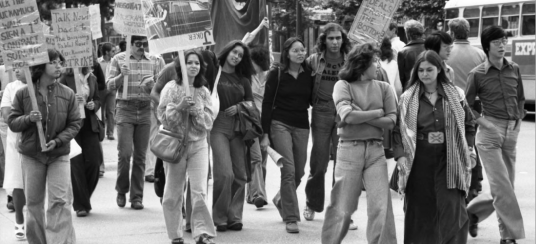
Muckamuck Restaurant
Indigenous peoples find themselves in a double bind: regardless of what “option” they choose—to live on sanctioned land or integrate into cities—Indigenous rights are routinely undermined. Vancouver’s Muckamuck Restaurant was a workplace where West Coast First Nations’ culture was commodified more than celebrated, and its staff members made to feel dispensable—as if mere conduits of the signifiers which customers paid to experience.
Muckamuck first opened in 1971 by three white American owners, and while the restaurant “maintained an informal policy of hiring First Nations people as restaurant staff,” its management was white [14]. Among other exploitative practices, Muckamuck management utilized the Canada Manpower Training Program, which meant that the restaurant received three quarters of any First Nation trainee’s wages from the government [15]. Former employee Ethel Gardner wrote a statement about employee conditions for The Indian Voice, a First Nations newspaper in Vancouver:
Breaks were few, if any. Heavy fines were given out for petty reasons, like not tying garbage bags, or forgetting to put tin foil over bannock. Staff meetings were held every week, and it was compulsory to go to these meetings … At these meetings, employees were put down for every possible mistake that could have been made on the job, big or small, true or false. According to the owners, it seemed like the workers couldn’t do a thing right. Maybe because the workers were Indians? I doubt it … For too long the fact that Native workers in B.C. are badly treated has gone unnoticed. At the Muckamuck we are told by our management that we are slow, stunned, inexperienced and hard to train, rude, stupid and ungrateful for the beautiful place that they have built for us … to work. [16]
While working conditions were unethical, the option to unionize was an unattractive concept to First Nations workers. Janet Mary Nicol introduces her essay “Unions Aren’t Native” with a quote by Gardner, wherein she explains to the then “skeptical First Nations community” that in “this society … being in a union is the only way we can guarantee that our rights as workers will be respected” [17]. The concept of a union was not an easy sell; Muckamuck employees wondered how a traditionally European system would be able to help them.
The restaurant workers eventually decided to unionize in 1978, and chose the Service, Office and Retail Worker’s Union of Canada (SORWUC) to represent them. SORWUC seemed to be the most natural fit, due their shared recognition for the intersectional “layers of oppression” of sex, race, and class, “because of their own experiences as women workers in occupational wage ghettos neglected by organized labour” [18]. The strike, which lasted four long years, saw workers and union allies picketing seven days a week to discourage patronage of the restaurant [19]. As the strike progressed, less original Muckamuck employees were present and the picket line became increasingly occupied by “SORWUC members, other trade unionists and supporters,” maintaining the necessary community alliances which would weather years of protest [20]. It could have looked quite odd to the passer-by, however, as the majority of picketers over time were white, and West Coast First Nations strikebreakers would enter the restaurant to work. Sandra Eatmon, another former Muckamuck employee, suggested that “if a First Nations group had done the organizing, First Nations people may have stayed on the picket line a bit longer” [21].
While picket protesting was a popular union tactic in the 1970s, unions were still primarily white and formed to work within colonial contexts. Nicol writes in her essay’s conclusion that although “SORWUC was ideologically committed to racial issues…[they] functioned within an adversarial and hierarchical trade union structure and culture,” and that “First Nations peoples’ ways of dealing with conflict, negotiation and decision-making were not introduced into the process” [22]. By the time the messy strike came to a close in 1983, B.C.’s Labour Relations Board “ruled that management owed the union $10,000 in compensation,” but “SORWUC has never been able to collect this money, as the employer moved back to the United States” [21].
Timely Reflections
Whether allegiance takes the form of parallel online protests, physically joining in acts of civil disobedience, or cooperating through traditional structures such as union interventions, protests take time and resources and must stand the test of changing climates. Shifts in media focus or in protesters’ priorities can mean that allies grow apathetic—or, conversely, that allies must take up the picket and become stewards of social justice. Staying connected means that activists are willing to fight while waiting.
In both the Muckamuck Restaurant labour dispute and the Standing Rock “No DAPL” protests—or, for that matter, in the many pipeline protests which fight against the denial of Indigenous consultation—time plays a significant role in determining the structure of the activist tactics involved. We cannot be certain how long we will need to stand up with Standing Rock before an effective and respectful decision will be made, and likewise with the Coast Salish peoples of British Columbia in opposition to the Kinder Morgan pipeline; if Muckamuck has taught us anything, it may be years before such pipeline protests are resolved. The question is, are we willing to fully dedicate ourselves to the issue and go beyond a simple Facebook check-in? Moreover, are we missing the point by merely following the example of our hoards of online friends?
Solidarity is more than a herd mentality. Tactics of protest must ultimately mirror the values of the peoples whose rights are being advocated for. While the Muckamuck dispute was successful in terms of the official recognition that the workers received, the approach of that protest did not go as far as it could have to make sure that West Coast First Nations workers’ voices were heard. Working within the hierarchical system of unions meant that Muckamuck staff were unable to employ their own systems of dispute resolution. New tactics such as online activism can also make this mistake; through monotonous scrolling and button clicking, it becomes to read headlines rather than find articles or quotes directly from members of the frontline. When considering the expansive list of issues facing Indigenous peoples in North America (Standing Rock, Truth and Reconciliation, Missing and Murdered Indigenous Women and Girls, Kinder Morgan, Inuit in Crisis, et al.), decolonial allies must fight against their selective hearing, work to amplify the voice of Indigenous activists, and learn the sometimes painful patience necessary to see protests’ successful outcomes.
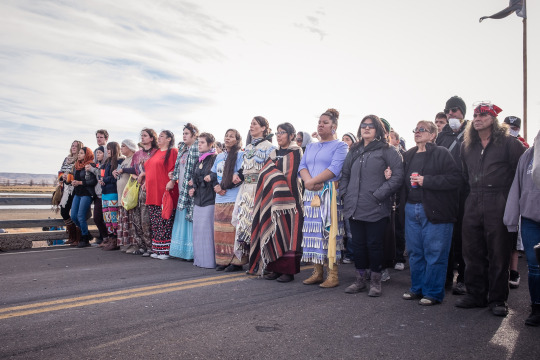
Text
Alexandra Bischoff
Notes/Sources
[1] News, BBC. “What Is Standing Rock and Why Are 1.4m ‘checking In’ There?” BBC News. BBC News, 2 Nov. 2016. Web. 2 Nov. 2016.
[2] Ibid.
[3] LaCapria, Kim. “Facebook Check-In at Standing Rock.” Snopes. Snopes, 31 Oct. 2016. Web. 2 Nov. 2016.
[4] Seeman, Neil. “Don’t Mistake 'Likes’ on Facebook For Real Social Change.” The Huffington Post. TheHuffingtonPost.com, Inc., 19 Nov. 2013. Web. 4 Nov. 2016.
[5] Wysocki, Aaron, and Cenk Uygur. “Susan Sarandon Interview with Cenk Uygur on The Young Turks.” The Young Turks. TYT Netwrork, 04 Nov. 2016. Web. 4 Nov. 2016.
[6] Some of the banks which contribute to the oil companies involved in DAPL are Canadian. To check to see if you keep an account with one of them, you can reference this list: https://goo.gl/sefiul.
[7] Walker, About Taté. “3 Things You Need to Know About Indigenous Efforts Against the Dakota Access Pipeline.” Everyday Feminism. Everyday Feminism, 07 Sept. 2016. Web. 10 Nov. 2016.
[8] Sammon, Alexander. “A History of Native Americans Protesting the Dakota Access Pipeline.” Mother Jones. Mother Jones and the Foundation for National Progress, 9 Sept. 2016. Web. 8 Nov. 2016.
[9] Monet, Jenni. “Mainstream Media MIA as DAPL Action Is Met With Water Cannons and Mace.” Indian Country Today Media Network.com. Indian Country Today Media Network, LLC, 21 Nov. 2016. Web. 21 Nov. 2016.
[10] Flyinghorse, Deb. “Click Here to Support Help Build a Winter Clinic for Standing Rock.” YouCaring. YouCaring, 6 Nov. 2016. Web. 8 Nov. 2016.
[11] Hersher, Rebecca. “Obama: Army Corps Examining Possible Rerouting Of Dakota Access Pipeline.” NPR. NPR, 2 Nov. 2016. Web. 4 Nov. 2016.
[12] Boccagno, Julia. “Climate Change Denier Is Leading Trump’s EPA Transition Team.” CBSNews. CBS Interactive, 11 Nov. 2016. Web. 13 Nov. 2016.
[13] Nicol, Janet Mary. “"Unions Aren’t Native”: The Muckamuck Restaurant Labour Dispute, Vancouver, B.C. (1978-1983).“ Labour / Le Travail 40 (1997): p 2. Web. 13 July 2016.
[14] Ibid. p 3
[15] Ibid. p 4
[16] Ibid. p 1
[17] Ibid. p 5
[18] Ibid. p 11
[19] Ibid. p 11
[20] Ibid. p 9
[21] Ibid. p 16
[22] Ibid. p 15
Images
Image identifier: MSC160-396_03; August 12, 1978. Courtesy of the Pacific Tribune Photograph Collection, a digital initiative of Simon Fraser University Library.
Matt Hamon, “The Stand at Standing Rock”, 2016. http://www.matthamon.com/the-stand-at-standing-rock-2. Courtesy of Matt Hamon.
Matt Hamon, “The Stand at Standing Rock”, 2016. http://www.matthamon.com/the-stand-at-standing-rock-2. Courtesy of Matt Hamon.
#indigenous activism#No DAPL#bankexit#i stand with standing rock#Standing Rock#Muckamuck Restaurant#Vancouver protests#Vancouver pickets#union disputes#SORWUC#activism#First Nations activism#First Nations
1 note
·
View note
Photo
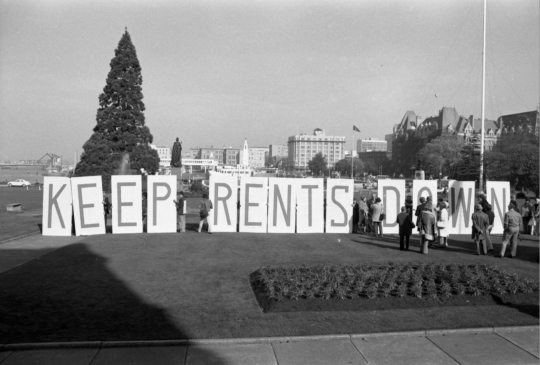
October 23, 1974: Presentation of Tenants Lobby petition in Victoria, B.C.
BC Tenants Organization, supported by BC Federation of labour and labour councils, holds a rally in Victoria calling on government not to permit rent increases above the existing 8% ceiling in October of 1974.
Maximum rent increases in BC for 2016 were 2.9%; much less than what lobbyists were fighting for in the 1970s, but still higher than the 2.2% of 2014 [1]. 2017 maximum rental rates have been raised to 3.7% [2].
Notes/Sources
[1] Province of British Columbia. "Rent Increases." Office of Housing and Construction Standards. Province of British Columbia, 19 Aug. 2016. Web. 22 Nov. 2016.
[2] Ibid.
Image
Image identifier: MSC160-98-18A; dated October 23, 1974. Courtesy of the Pacific Tribune Photograph Collection, a digital initiative of Simon Fraser University Library.
#rent#vancouver rent#keep rent down#rental increases#vancouver housing crisis#tenants lobby petition
0 notes
Photo
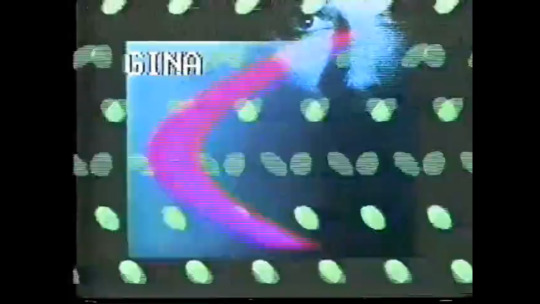
The GINA Show Archive: Vancouver Video Memory in Motion
Text by Allison Collins
The GINA Show” was a television program that aired on public access cable, Vancouver Cable 10, from 1978-1981. Named after hostess Gina Daniels, the show was produced by Vancouver-based artist John Anderson (a.k.a. J. A. Genius) and consisted of 20- to 30-minute episodes of video art, performance art documentation, interviews with artists and bands, poetry readings, promotional spots for art galleries and exhibitions, punk and new wave music videos, and early digital animation. The show began as a project run out of PUMPS Centre for the Arts, an early Vancouver artist-run centre that was a central gathering place for a generation of artists from 1975 to 1980. “The GINA Show” was conceived of as a variety TV-show run by artists and a platform for public screenings. It capitalized on the relationship between the medium of video and television as its viewing apparatus, using cable broadcast as a way to bring art into the homes of the local viewing public.
In the mid-1970s, cable access channels offered a viable place to make an incursion into the milieu of increasingly corporate television programming. Artist-driven shows and short-term broadcasts began to appear in many forms throughout Canada, the U.S., and in Europe shortly after the 1967 release of the first commercially available handheld video camera, the Sony Portapak. [1] In Vancouver, early cable access shows included the 1974 program “Images From Infinity” which ran for one year and was produced by filmmaker and performance artist Byron Black. An acknowledged influence on Anderson, Black’s show pioneered the variety show format, with guest spots by artists such as Dana Atchley (Ace Space), Peter Schuyff, Hank Bull, and Kate Craig (Lady Brute), among others. The guests and studio hosting was combined with 35-mm colour slides and Akai 1/4-inch video shot optically off of a small studio monitor. [2]
Vancouver Cable 10 ran a range of community programs during this era of experimental performance and media work, including two programs dedicated to the music scene, “Nite Dreems” and “Soundproof,” and a show produced by a collective of Fine Arts students at UBC called “TBA TV”. Records of these forays into cable are now becoming scarce, or when they are available, are beginning to degrade. The 3/4-inch tapes of the original “TBA TV” broadcast, for example, remain packed away in boxes waiting for a time when the contents will be valued enough to warrant the transfer of their content into a more stable format. [3]
“The GINA Show” records are no exception to the problem of unstable physical material. The tapes contain moving images and sounds, but the passage of time has rendered them into still objects. The physical remains of the original 3/4-inch tapes are no longer used for viewing; having survived a studio fire, they now rest in the archives of the Morris and Helen Belkin Art Gallery, more fragile than they would have typically been at the 30-year mark. Because the original cassettes are inadequate to store content, the episode data has been transferred from the old tapes (3/4-inch U-matic) to archival tapes (Digibetacam), sub-master tapes (MiniDV), and digital copies (DVD). The physical material has a short lifespan and the equipment on which to play it is becoming relatively scarce. Media migration has therefore become a necessary step for video works from this era in order to ensure that they survive and remain viewable. Despite these efforts to preserve it, many episodes of “the GINA Show” have been damaged beyond transfer or have become imperfect translations. Time and circumstance have rendered the records incomplete and the new versions are sometimes partial or distorted.
The challenges of media preservation, however, go beyond material state. Recordings can never encompass a perfect rendering of the past. At best, material traces can transport some physical inscription of an image from the past to the present, yet what is rendered is inevitably a flawed representation. As Eduardo Cadava writes,
… in every image, in every trace and consequently every experience, there is this explosion and incineration, which is experience itself. Effacing what it inscribes, the image bears witness to the impossibility of testimony. It remains as a testament to loss.[4]
The loss refers to the specificity of an embodied moment at a particular time and place. What remains becomes a ghost of the original experience. “The GINA Show” archive is likewise a partial record. It holds within it a material presence of absence. In this respect it will always indicate the loss of that moment, and thus always exist in the present as a distortion of the past.
The show was produced on a shoestring budget, as much a product of its social community as it was a venue for working artists looking to gain exposure on television. Those who worked on the show often gathered together at The Cecil to watch the latest episode and, inevitably, to watch themselves. [5] As Sara Diamond notes, it was an era of recording and “the very presence of a video camera suggested that an event was worthy of notice and entry into the historical record.”[6] The events on “the GINA Show”, 30 years later, construct just such a record of their particular historical moment.
Of the 90 episodes that initially aired, 63 remain—approximately 28 hours of video footage. These hours are populated by contributions from artists who showed primarily at PUMPS, but also at The Western Front, Video Inn, and the Vancouver Art Gallery. What is contained in the footage is an extensive visual recording of the activities undertaken by these artists and these places, during a moment characterized by both dissatisfaction and optimism. This conflicting spirit lingers amidst the works and people on the recordings – the DIY mentality and the gritty earnest style and aesthetic of the punk and new wave scene in the late 1970s. The artists of this time started their own exhibition spaces and production centres, created hundreds of exhibitions and events, made their own books, and advertised it all on a low budget with roughly drawn and photocopied flyers. PUMPS was such an artist-initiated space: a production centre, a gallery, and also a home to some of its directors over the years.
A lifestyle, more than an artistic statement, the do-anything experimentation of artistic production in this era was merged with the social. Martha Rosler describes this phenomenon, common to many early video producers, as “not only a systemic but also a utopian critique…” and an effort “not to enter the system but to transform every aspect of it …to redefine the system out of existence by merging art with social life and making audience and producer interchangeable.”[7] A vast quantity of work was made and shown in Vancouver at this time, in a diverse range of media, but video in particular came to capture the moment. The broadsheet Video Guide, an artist-driven newspaper dedicated to issues arising in video production was launched at this time, published by the Satellite Video Exchange. Its appearance filled a need among artists experimenting in new media to dialogue and engage critically with the increasing amounts of work being made. The magazine’s content included reports on conferences and events, exhibition reviews, technical discussions, artist interviews, coverage of community cable and decisions of the CRTC. In many cases, the same material would appear in an exhibition, as a review in Video Guide, and in an excerpt on “the GINA Show”.
“The GINA Show” took the same principle of discussion and applied it to television. Gina Daniels and John Anderson hosted the show together. On camera, they interviewed artists and bands, introduced programming for that week, showed video clips, and spoke to, with, and about their own community of friends and associates. Frequently, content on the show related to an event occurring in Vancouver, and it thus became a vehicle to promote exhibitions, screenings, and performances. These promotional spots were punctuations that stitched the shows together, recurring from episode to episode and often previewing the next week’s content, in effect situating the show as a time-based television event. Acting as artist, editor, curator, and promoter, Anderson used each episode as a platform for showing new work, to announce what was going on in the galleries he was involved with, and to chronicle the local scene. He made and featured many promotional clips, which were essentially free commercials for art events and exhibitions, sometimes as rudimentary as a person holding a series of handwritten signs in front of the camera with background music or a voiceover.
An early example of a video segment that acted as a commercial for artists was the announcement for Video Cabaret. This event series was co-produced by Western Front, Video Inn, and PUMPS, and took place at PUMPS from November 22 to 25, 1978. A multi-media video, performance, and live music event, Video Cabaret was described as a combination of “elements of video, rock ‘n’ roll, and the visionary theories of Marshall McLuhan and Aldous Huxley in theatrical format.”[8] The spot on “the GINA Show”, which aired on November 21, announced the series, and included excerpts from Hummer Sisters videos. The clips of video work were followed by a silent shot that zoomed in on a set of flyers, as well as a post-punk performance by Andy Paterson (a member of the Hummer Sisters) and his band The Government.
In quick succession, clips on the show come together as a kind of visual equivalent to a radio show. Anderson took a strong interest in remixing and editing to create the episodes and he cites the influence of disc jockey J.B. Shayne in the development of his interest in the concept of “the GINA Show.” [9] As with radio, the audience was frequently addressed directly by the hosts, who spoke directly to the home viewer about that week’s show content, despite the fact that the show was not live. Most episodes also incorporated and appropriated a lot of music— in the works, performance documentation, and as early music videos. Many of these clips borrow liberally from new music of the era by the likes of David Bowie, The Talking Heads, DEVO, Brian Eno, and Kraftwerk.
Incorporating music into video work was a common practice at the time. Byron Black pantomimed Spike Jones comedy albums, Elizabeth Vander Zaag made digital compositions to accompany “Digit”, David Ostrem set Yoko Ono’s song “Let’s Hope for Peace” against footage of Vancouver, Keith Donovan combined Super 8 footage with “Why Can’t We Live Together” by Timmy Thomas, and Kim Tomczak incorporated Iggy Pop’s “New Values” into his work “100 Years of Aggression”. This musical aspect is entertaining, and mixes well with the documentation of live music and early music videos by Mike MacDonald, Lenore Coutts (a.k.a. Doreen Gray, now Lenore Herb), and John Anderson. Most of the time, these performances were by local bands of Vancouver’s early punk and new wave music scene, such as The Pointed Sticks, The Modernettes, (later Los Popularos), ‘e’, The Braineaters, UJ3RK5, The Subhumans, and The K-Tels (later renamed The Young Canadians).
The frequent overlap and crossover between bands and the artists was a natural event, as many were making music in the same bands that were being aired alongside their art. [10] On occasion a big musical event would occur, and local artsts who were music enthusiasts would respond. The 1980 performances of James Brown at The Cave, was one such event, and the resulting artistic output warranted a dedicated “GINA Show” episode. The show lent its credibility to the artists involved (Mark Oliver, Donna Chisholm, Anne Rosenberg, Nina Skogster, and Stan Douglas) who were emerging video and filmmakers at the time, but ultimately their enthusiasm and knowledge about Brown’s music granted them access to the music giant. An interview with Brown and footage of his live show was edited to air on the show, and John Anderson promoted the work enthusiastically. In moments like this “The GINA Show” served as a venue for video side projects and community moments, as well as a place to screen experimental work.
The work that found its way onto the show sometimes veered towards explicit television parody, as in Taki Bluesinger’s serial soap opera “The Edge of Sleep” (complete with melodramatic piano music) or Hank Bull’s evangelist spoof series “Relican” (“Religion Canada”). Other works were formal media experiments, as in the “Digit” series by Vander Zaag, a set of early computer animations that chronicle the existence of a digital female protagonist. Many of the works were made directly for the program, while others were simply screened, such as Jenny Holzer’s “Truisms” pieces, which consist of hurried readings of scrolling character-generated texts of cliché slogans to live by.
Throughout the three years it was on the air, “the GINA Show” broadcast just about every kind of work that intersected with media that was being made or shown in Vancouver. The show’s style was fun, edgy, optimistic, spontaneous, and countercultural in its use of the medium as both a creative endeavor and as a means to communicate beyond standard television programming. This came in part from the associations among the people involved in the show, people who performed and framed the mixture of art practices, excerpts, documents, discussions, and actions through an active repertoire.
Vancouver performance practices of this era— which are now mostly thought of as having developed in association with the Western Front— involved incorporating over-the-top personas and deploying campy theatricality in the name of art. The style of this performance, dubbed “haute-camp”, was strongly guided by a process of working together and by the social lives of the participants.[11] These performances came together as events that were a mixture of the personal with the spectacle, as with the “Relican Wedding”, when hostess Gina Daniels married Gary Bourgeois (a.k.a. Gary Middleclass). In a ceremony dubbed “A Middleclass Marriage”, this raucous “Religion Canada” event packed a crowd into PUMPS to witness an unusual nuptial ceremony, complete with proselytizing by “The Great Homunculus” (Hank Bull) and live music. Bull raised and lowered himself by rope from the ceiling and donned bizarre regalia to perform the ceremonial union. Daniels’ bridesmaids arrived riding on the hood of a car and lip-synch serenaded the couple, and all the while Gary Middleclass stood grinning widely, dressed in an army art-punk style with a black beret and aviator sunglasses. Throughout the broadcast of this surreal event, one can hear Anderson quietly directing the camera operator while “Religion Canada” text scrolls across the screen, soliciting money from viewers.[12] At the end of the segment, character-generated “Thank You” credits roll, listing people on a first-name basis only—a confirmation of just who would be expected to watch the broadcast that week.
Many important events in the local scene were screening on the show, including fractures that occurred within the community. Of particular importance to “the GINA Show” was the final public meeting held in 1980 by the board of PUMPS, when the gallery announced it would close. The centre had recently lost a portion of its funding, and its directors saw it as a five-year experiment that had by this time run its course.[13] In the process of their decision to close the doors, the fate of the gallery was discussed among irritated community members who wished to take up the reins (and the centre’s remaining funding and space). PUMPS had been home to many of its directors, who had personally built up a vibrant series of events at the production centre. When it closed, three directors (Sandra Janz, Chris Reed, and Tomczak) left the city to take up new challenges. Others remained behind, but all moved on to new things.
Months after the decision to close was made, a public airing of the meeting ran on “the GINA Show” in what was probably an utterly confusing episode for any casual viewers. A subsequent episode spliced together scenes from the frustrating meeting with footage of former PUMPS members sharing a relaxing day at the beach, using community cable as public form for a kind of community catharsis. The stark contrasting of the futile bureaucratic meeting with a sunny fresh day on the beach contained a readily apparent if unstated point as to why the directors may have chosen to move on. It was one of the last episodes of the show to air, and soon afterward, in the summer of 1981, “the GINA Show” ceased production.
Retrieving “the GINA Show” tapes to be seen again in public is an endeavor that is not without its challenges. The show contains copies of many minor works by artists who have gone on to great things. Copyright ownership and distribution concerns mean that the videos, when viewable, may only be borrowed from the archive after connections between the authors and their wayward works are reformed. In this process, the show once again finds itself with a social life.
The change in location of the show and all the information it contains helps to maintain this document of a moment and its practices. Located now within an institutional archive, “the GINA Show” performs its work of bringing a selection of practices into proximity with one another, generating a version of events through the co-mingling of its content. It is made of papers and tapes that comprise an anthology of local artwork. Charred and distorted as materials, the items left over from the original moment of broadcast continue the work of articulating a local scene to an ever-expanding public. As a hybrid artwork/archive, it is an early example of the secondary lives that artworks, especially video, can have—comprised of data that can be easily copied and rebroadcast. Now in its second-generation, “the GINA Show” as a document of its former activity, reforms connections to a moment that is increasingly distant, but not forgotten. Founded by a medium that must move in order work, the resulting images are a fast-paced rendering of this city’s wild youth that are once again set in motion. Although inscribed into objects, this image of local history simply won’t hold still.
Notes/Sources
[1] A few examples include “TVTV”, “Paper Tiger Television”, and “TV Party” in the USA, “Changing Channels” in Halifax, and “Television By Artists” in Toronto.
[2] The episodes were edited together on IVC one-inch helican-scan reels that are no longer in the possession of the artist, and by his account are likely destroyed. Surviving tapes are potentially degraded beyond the point of viewing, although some sub-master dubbed copies of certain episodes can be found in local archives.
[3] Bill Jeffries, a member of the TBA TV collective, in conversation with the author.
[4] Eduardo Cadava, “Lapsus Imaginus: The Image in Ruins” October 96 (Spring 2001), 49.
[5] Gina Daniels, in conversation with the author. In the 1970s and early- 1980s, The Cecil was a pub located at the north end of Granville bridge. The pub later became a strip club and, at the time of writing, is scheduled for demolition to make way for a new condominium project called the Rolston.
[6] Sara Diamond, “Daring Documents: The Practical Aesthetics of Early Vancouver Video” Vancouver Anthology: The Institutional Politics of Art. Stan Douglas Ed. (Vancouver, Talon Books with Or Gallery, 1991). 47.
[7] Martha Rosler, “Video: Shedding the Utopian Moment” Decoys and Disruptions: Selected Writings, 1975-2001. (Cambridge, Mass.: MIT Press with International Center of Photography, New York, 2004). 54.
[8] Donna Lypchuk, “The Hummer Sisters: The Art of Satire” Video Cabaret, online. March 30, 2010.
[9] Shayne co-hosted the 1979-1980 cable-access music show “Nite Dreems” and had a prolific early career on Vancouver independent radio.
[10] Jim Cummins was one of The Braineaters, Andy Paterson was a front man for The Government, Gary Bourgoeois and Gina Daniels were ‘e’, and Rodney Graham, Jeff Wall, Colin Griffiths, Kitty Byrne, Danice McLeod, Frank Ramirez, Divid Wisdom and Ian Wallace were the UJ3RK5.
[11] Jo-Anne Birnie Danzker, “West Coast Performance: Praxis Without Ideology?” in Vancouver Art and Artists: 1931-1983. (Vancouver: Vancouver Art Gallery, 1983) 304.
[12] The taped event is interspersed with still images from the event, and exists in a master format, which has a different variation of editing. Another version of the recording is held in both the Western Front and Video Out archives.
[13] Keith Wallace, “A Particular History: Artist-run Centres in Vancouver” in Vancouver Anthology: The Institutional Politics of Art. (Vancouver : Talon Books, 1991) 34.
Image
John Anderson, “The GINA Show”, excerpt from Season 3, Episode 5, intro sequence; originally broadcast December 8, 1980. 1:08 min. http://www.theginashow.orgallery.org/category/video-clips/. Courtesy of John Anderson and the Morris and Helen Belkin Art Gallery.
#The Gina Show#Vancouver video#Vancouver in the 70s#media arts#PUMPS artist run centre#Video art#video
0 notes
Photo
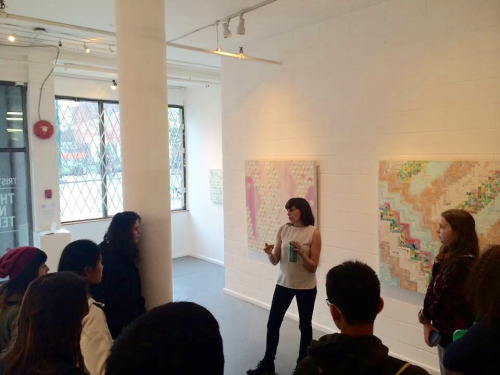
Reactivating: Mentorship and the Archive
Text by Micaela Kwiatkowski
Women working in art, archives and activism in Vancouver came together on June 13th, 2016 to engage in a critical discussion around the absence of female cultural producers within the archive. The event, Reactivating: Art and Archives was hosted by the Morris and Helen Belkin Gallery and consisted of an “open-space” discussion where participants generated topics and broke into groups to discuss issues surrounding feminism, documentation and community.
One of these discussions developed between the intersection of “cross-generational” and “mentorship” as ways to dismantle systems of patriarchy within the art community. The discussion brought up examples of misrepresentation in archival holdings such as Kate Craig’s, “who documented the action at the Western Front but was never considered an author or creator of it”. [1] Mentorship can contribute to the archive by enabling young women with the knowledge and resources to participate and reflect on the construction and understanding of it. The conversation questioned the hierarchical structure of mentorship by asking participants whether or not the word mentorship carries the reciprocal characteristics that participants had experienced in cross-generational relationships; the group shared several encounters where they learned from students while teaching or advising them. One of the participants attributed this to feminist theorist Karen Barad’s concept of intra-action in Meeting the Universe Halfway where she explained Barad’s concept of intra-action as “the idea that things do not exist until they come into action with one another” and related it to how “new things come into being” through the exchange that happens in a mentoring relationship. [2] Barad mirrors this description as “ the ongoing practice of being open and alive to each meeting, each intra-action, so that we might use our ability to respond, our responsibility, to help awaken, to breathe life into ever new possibilities for living justly”. [3] Another participant connected this exchange to Helen Molesworth’s metaphor in How to Install Art as a Feminist where the sibling/cousin relationship holds the most significance because of its horizontal nature rather than the traditional father/son or master/apprentice relationship. [4] With these concepts in mind the group concluded with a collection of ideas on how to enact and create spaces for these reciprocal cross-generational relationships to develop and encourage women in the community to engage with the archive in an effort to re-contextualize it.
Reactivating: Art and the Archive is going to continue this dialogue with a second event on Wednesday, October 5th from 2:30- 5:00pm at VIVO Media Arts Centre.
Notes/Sources:
[1] Reactivating: Art and Archives. July 13, 2016. Vancouver. Taken from transcription.
[2] Ibid.
[3] Karen Barad, Meeting the Universe Halfway. Durham: Duke University Press (2007): p.x.
[4] Helen Molesworth, “How to Install Art as a Feminist”. Modern Women: Women Artists at the Museum of Modern Art. Ed. Cornelia Butler and Alexandra Schwartz. New York: Museum of Modern Art (2010): p. 507.
Image:
Tour and introduction by Julia Kreutz as part of Satellite Gallery’s G08 Youth Internship Program, 2015. Courtesy of Gam Gallery.
1 note
·
View note
Photo

A brief history of Canadian abortion services
The decriminalization of abortion in Canadian legislation has a strained history. A dense and tumultuous narrative—which includes omnibus bills, filibusters, a caravan of protesters, the first forcible adjournment of the House in Session in Canadian history, and a definitive ruling two decades after the discussion began—the tale of pro-choice politics in Canada has gone through multiple sub-plots.
Until 1968, abortion in Canada was illegal. Pierre Trudeau, the Canadian Prime Minister from 1968-1984, was responsible for the Criminal Law Amendment Act, 1968-69, otherwise known as Bill C-150 [1]. It was an omnibus bill that tightened or redressed a number of criminal offenses, including the sale of contraceptives, homosexuality and abortion.
Bill C-150 made abortion available to women under a strict set of conditions. In order to receive treatment, a pregnant woman would have to obtain signature permissions from at least three doctors, each in agreeance that the pregnancy endangered the emotional, mental or physical well-being of the woman. While this redress provided a necessary step towards women’s independence, the amendment was expectedly unsupported on both ends of the political spectrum.
On the far political right, this new, condition-specific legalization was deemed immoral. Among other critics, the Catholic Creditistes of Quebec held up the parliamentary debate for three weeks, demanding a public referendum on the issues of homosexuality and abortion. They also staged a filibuster in Parliament over the amendments specifically concerning abortion—arguing, among countless other things, about the legal implications of doctors, nurses, or hospitals who would prefer to deny women these services on moral grounds [2].
Women, on the other hand, denounced the abortion amendment on the grounds that they did not make abortion available enough. The narrow framework wherein abortion could be granted left feminists demanding a level of female autonomy that the government was not yet prepared to give. These demands were protested across the country, organized by women’s groups in each province. One such country-wide protest began in Vancouver on April 27, 1970, with an assembly of women from the Vancouver Women’s Caucus (1968-1971), who set out in vans and cars covered in pro-choice slogans and headed for Ottawa [3].
One of their slogans was “The Women are Coming”—a portentous phrase that maintained the feminist movement was not to be ignored. They took with them a hand-crafted cardboard coffin, filled with coat hangers to represent the deaths of women from illegal abortion—the number of which exceeded 2000 a year, according to Vancouver Women’s Caucus statistics [4]. Calling themselves the Abortion Caravan, these women made a total of 12 stops across the country on their way to confront Trudeau, where they held rallies and press conferences, and caused Canadians to consider their stance on a topic that was previously left undiscussed [5].
The Caravan strategically arrived on Parliament hill for Mother’s Day weekend that May, where 500 protesters staged several large demonstrations over a two day period [6]. One group burned the Prime Minister in effigy, another 300 women marched to deliver their DIY coffin filled with coat hangers to 24 Sussex Drive, and a separate group made their way inside the House to shout “free abortion on demand.” Several women involved in the latter event chained themselves to the chairs in the visitors’ galleries, causing such a scene that the session was forced to take recess for over an hour. Not only was this the first national feminist demonstration in Canada [7], it was also the first time that the House in Session was forcibly adjourned [8] in its 103-year history.
Despite the impressive, eyebrow raising efforts of our feminist caravan trail-blazers, these abortion amendments were not repealed until 1988. While women of all creeds fought to have their voices heard, it was the martyr-worthy legal struggles of Dr. Henry Morgentaler that eventually caused reform in the landmark case of R v Morgentaler [9].
Morgentaler defied the abortion amendment from its inception, performing abortions in his Quebec office as early as 1969. His office was subsequently raided and he was charged with conspiracy to perform an abortion [10]. Between 1970-1988, Dr. Morgentaler was charged and acquitted, the decision repealed and the doctor found guilty, and then acquitted again to have the cycle of incrimination ceremoniously repeated. The final acquittal of Morgentaler’s charges would mean freedom of choice for all Canadian women.
The case of R v Morgentaler was laid to rest on January 28, 1988, when the Supreme Court of Canada struck down Canada’s abortion law as unconstitutional. The decision was cause for great relief. And while Morgentaler would later write in his memoirs that he practically single-handedly “abolished a restrictive, cruel, barbarous law which caused so much suffering to women across Canada,” the voices of Canadian women in the matter should not be underestimated [11]. It was due to high-profile protests such as the Abortion Caravan—which ignited debate amongst previously silent individuals—as well as the continued efforts of pro-choice activism, that the famed 1988 decision could have come to fruition. After all, little attention would have been given if women had not rightfully rebuked the injustice.
These victories are certainly worth celebrating, but unfortunately do not mean that the battle is over. Daily, we are given constant reminders that, both in Canada and abroad, women and allies must remain vigilant to defend pro-choice politics. In Canada, abortion services are not equally available in all provinces [12]. B.C. has 16 facilities which offer abortion, for example, whereas the prairie provinces share 8, and Atlantic Canada has a total of 4—PEI having none. Disturbingly, in 2015 a new Abortion Caravan was spawned—this time through the Canadian Centre for Bio-Ethical Reform, touting pro-life rhetoric that positioned itself as a radical new wave to replace the efforts of the 1970s original [13].
In the United States, the legal protection of women’s right to choose is under perpetual threat. The awe-inspiring filibuster of Texas Democrat Wendy Davis [14] barely prevented an anti-abortion bill in 2013, and the pro-life rhetoric of Republican Presidential Nominee Donald Trump has been proven to be woefully outdated [15]—representing the reality of understanding for many American citizens.
Women of all nations contribute to the fight of women’s reproductive rights. The Dutch collective Women on Waves (founded in 1999) use a ship with a licensed doctors office to “provide contraceptives, information, training, workshops, and safe and legal abortion services outside territorial waters in countries where abortion is illegal.” [16] According to the radical organization, “In international waters (12 miles off the coast of a country) the local laws do not apply,” making it possible to assist women in need, irrespective of the cultural and legal stigma involved [17]. The documentary Vessel chronicles Women on Waves and their abortion providing crusades, reminding viewers who already have the right to choose what is at stake in countries with more conservative Criminal Codes.
Poland is one country where abortion laws are extremely tight. Currently, a woman can only receive an abortion for three reasons: “a severely damaged fetus, danger to the mother's health and conception after incest or rape.” [18] A proposition was announced in September of 2016 that would change the current law to remove these three circumstances from legal sanction, making abortion a prisonable offence for both the woman and her doctor. In response, large protests amassed in Poland’s streets. On the Monday before ministers voted on the bill, some “100,000 people, mostly women, protested against the proposals” in cities across the country [19]. The final vote later that week was a landslide 352 to 58 in favor of pro-choice activism, proving once again that protest mobilization can kindle progressive politics [20].
Text
Alexandra Bischoff
Notes/Sources
[1] "Criminal Law Amendment Act, 1968-69." Wikipedia. Wikimedia Foundation, 23 Sept. 2016. Web. 20 Oct. 2016.
[2] Canadiana. "House of Commons Debates, 28th Parliament, 1st ... - Canadian Parliamentary Historical Resources." House of Commons Debates, 28th Parliament, 1st ... - Canadian Parliamentary Historical Resources. Library of Parliament, n.d. Web. 28 Oct. 2016.
[3] Wasserlein, Frances Jane. "An Arrow Aimed At the Heart" The Vancouver Women's Caucus and the Abortion Caravan. Thesis. Vancouver, Simon Fraser University, 1990. Vancouver: Simon Fraser U, 1990. Web. 22 Oct. 2016.
[4] F-111-2-0-9 Women’s Caucus – Abortion Cavalcade/Abortion Caravan; Confront Ottawa Pamphlet. SFU Access to Memory Archives, circa Apr. 1970. Print. Jul. 2016.
[5] Sethna, Christabelle, and Shannon Stettner. "The Women Are Coming; The Abortion Caravan of 1970." ActiveHistoryca. Active History, 11 May 2015. Web. 24 Oct. 2016.
[6] "Abortion Caravan." Rabble.ca. Rabble, n.d. Web. 22 Oct. 2016.
[7] "Fighting the Good Fight: Legalized Abortion in Canada." Canadian Public Health Association. Canadian Public Health Association, n.d. Web. 22 Oct. 2016.
[8] "Abortion Caravan." Wikipedia. Wikimedia Foundation, 14 Sept. 2016. Web. 22 Oct. 2016.
[9] Reid, Michelle Siobhan. "1988 Decision." The Morgentaler Decision RSS. Abortion Rights Coalition of Canada, n.d. Web. 24 Oct. 2016.
[10] "A Legal History Of Abortion In Canada." The Pro-Choice Action Network. The Pro-Choice Action Network, n.d. Web. 24 Oct. 2016.
[11] Reid, Michelle Siobhan. "1988 Decision." The Morgentaler Decision RSS. Abortion Rights Coalition of Canada, n.d. Web. 24 Oct. 2016.
[12] Young, Leslie. "Abortion Access Varies Widely across Canada." Global News. Corus Entertainment Inc. Corus News, 26 Nov. 2014. Web. 24 Oct. 2016.
[13] "The New Abortion Caravan." Canadian Centre for Bio-Ethical Reform. Canadian Centre for Bio-Ethical Reform, 2015. Web. 24 Oct. 2016.
[14] Bassett, Laura. "Wendy Davis Celebrates 1-Year Filibuster Anniversary." The Huffington Post. TheHuffingtonPost.com, 25 June 2014. Web. 20 Oct. 2016.
[15] Cauterucci, Christina. "Samantha Bee Schools Donald Trump on the Finer Points of Abortion Policy." Slate Magazine. The Slate Group LLC, 25 Oct. 2016. Web. 24 Oct. 2016.
[16] "Who Are We?" Women on Waves. Women on Waves, n.d. Web. 24 Oct. 2016.
[17] Ibid.
[18] Murray, Don. "Poland's Proposed Ban on Abortion Part of Broader Push to Turn Back History." CBCnews. CBC/Radio Canada, 04 Oct. 2016. Web. 26 Oct. 2016.
[19] News, BBC. "Poland Abortion: Parliament Rejects Near-total Ban." BBC News. BBC, 6 Oct. 2016. Web. 28 Oct. 2016.
[20] Ibid.
Images
Errol Young, Pro-Choice Protest photo originally published in “Saturday Night” magazine (1970), circa April, 1970. Simon Fraser University archives, Women’s Bookstore fonds: F-111-2-0-9 Women’s Caucus – Abortion Cavalcade/Abortion Caravan. Courtesy of Errol Young.
Handmade protest sign, circa April, 1970. Simon Fraser University archives, Women’s Bookstore fonds: F-111-2-0-9 Women’s Caucus – Abortion Cavalcade/Abortion Caravan. Courtesy of Simon Fraser University.
#Abortion Caravan#Canadian politics#abortion in Canada#Bill C 150#Activism#Protest#Women's Caucus Vancouver#Vancouver activism#1970s Vancouver#Women on Waves#feminism#feminist activism#Abortion#creative protest
0 notes